Pioneer K026 Multi- Media AVN Navigation Server System with BT User Manual 3
Pioneer Corporation Multi- Media AVN Navigation Server System with BT 3
Pioneer >
Contents
- 1. User Manual 1
- 2. User Manual 2
- 3. User Manual 3
- 4. User Manual 4
- 5. User Manual 5
User Manual 3
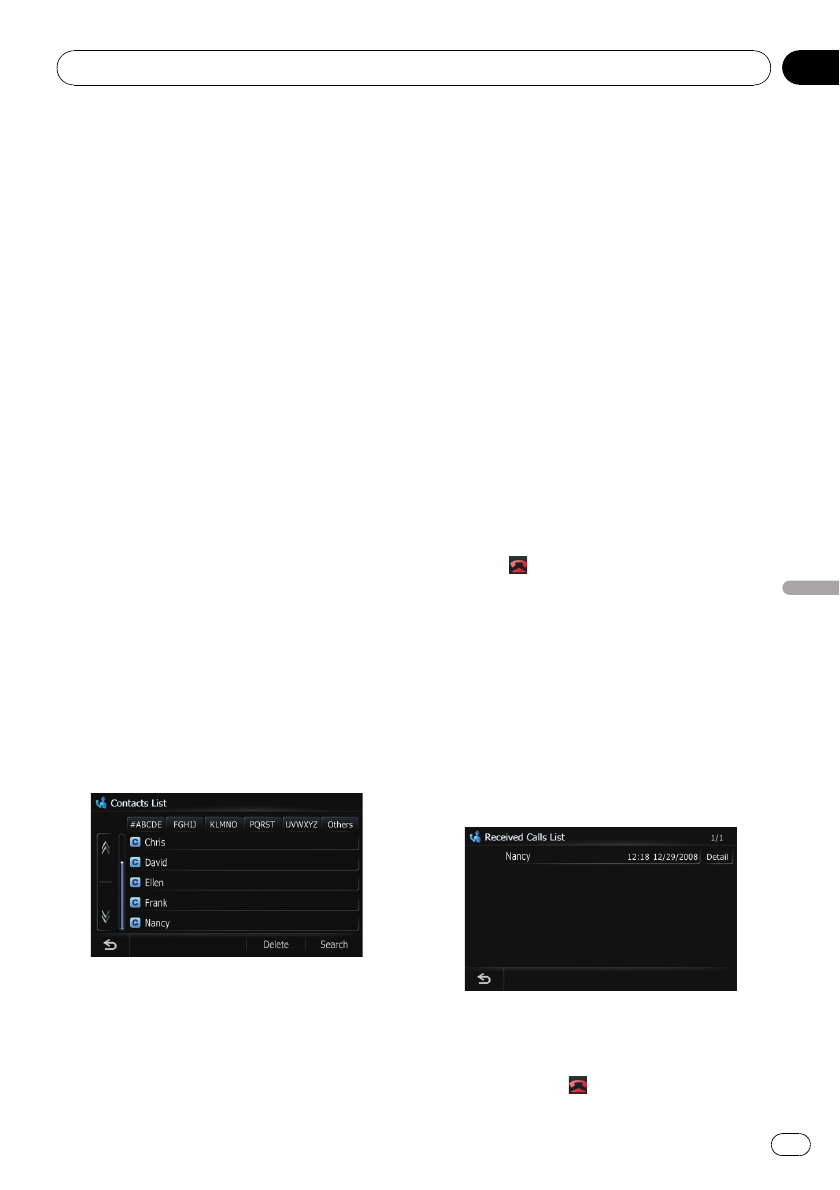
Making a call home easily
You can call home without taking the time to
enter the phone number if the phone number
has been registered.
1 Display the “Phone Menu”screen.
2 Touch [Call Home].
Dialing home starts.
pIf you have not registered your home num-
ber, a message appears. Touch [Yes]to
start registration.
=For more details about “Set Home”,
refer to How to use the navigation menu
screens on page 34.
Calling a number in the
“Contacts List”
After finding the entry you want to call in the
“Contacts List”screen, you can select the
number and make the call.
pBefore using this function, you need to set
the phone number from the phone book to
“Contacts”.
=For details, refer to Transferring the phone
book on page 84.
1 Display the “Phone Menu”screen.
2 Touch [Contacts].
The “Contacts List”screen appears.
3 Switch the page of the list to display
the desired entry.
If you touch an alphabet tab, you can jump to
the first page of the contacts whose names
start with that letter.
Alphabet tabs
Makes the screen jump to the beginning of
the page including the entry whose names
start with any of selected alphabets.
Touching [#ABCDE] also displays the page in-
cluding the entry whose names start with pri-
mary symbols or numbers.
Touching [Others] displays the page including
entries that are not assigned to any of the
other tabs.
4 Touch the desired entry on the list to
make a call.
!New translation required.
#Touch [Search].
The “Contacts Name Search”screen appears.
New translation required.
#Touch [Delete].
The “Delete from Contacts”screen appears.
New translation required.
5 Touch to end the call.
Making a phone call using the
received call history
The received call history saves 30 calls per re-
gistered cellular phone. If the number of calls
exceeds 30, the oldest entry will be deleted.
1 Display the “Phone Menu”screen.
2 Touch [Received Calls].
The “Received Calls List”screen appears.
3 Touch an entry on the list.
Dialing starts.
pTo cancel the call after the system starts
dialing, touch .
Using hands-free phoning
En 81
Chapter
12
Using hands-free phoning
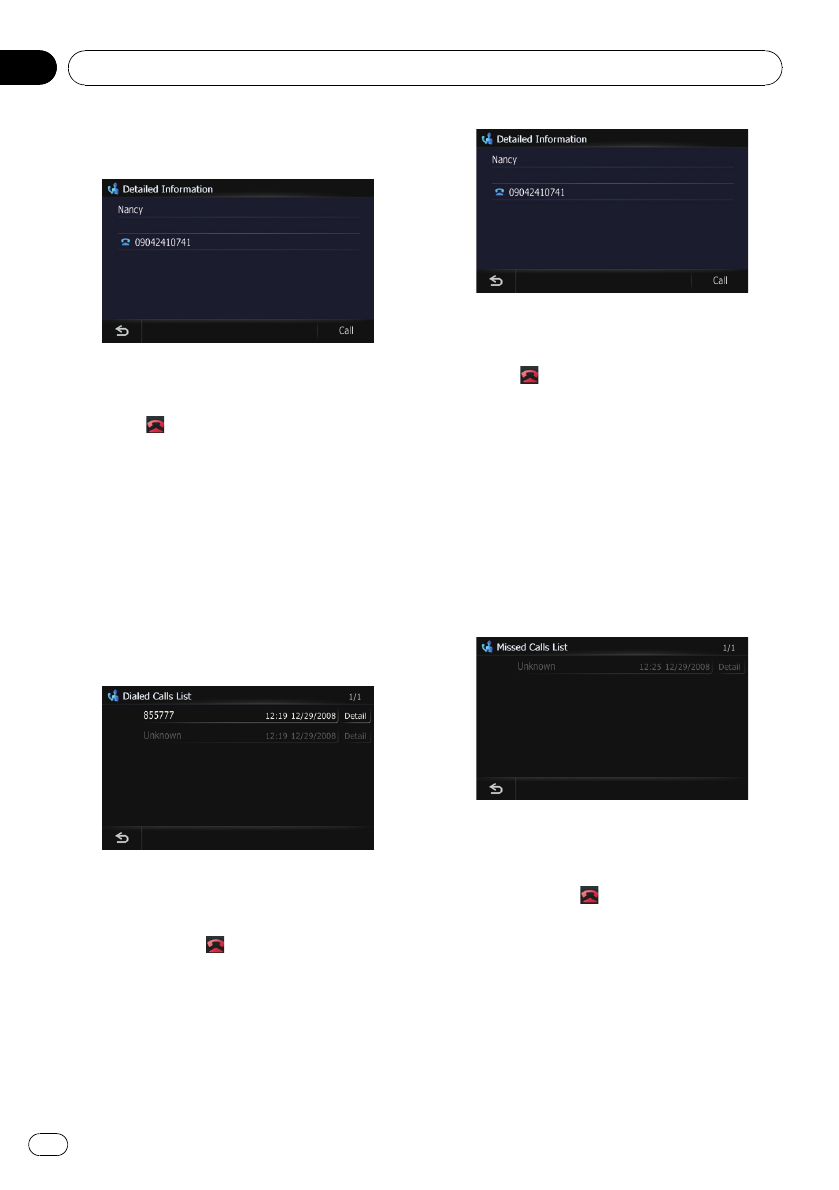
#Touch [Detail].
The “Detail Information”screen appears.
You can check the details of the party before mak-
ing a phone call.
4 Touch to end the call.
Making a phone call using the
dialed number history
The dialed number history saves 30 calls per
registered cellular phone. If the entries exceed
30, the oldest one will be deleted.
1 Display the “Phone Menu”screen.
2 Touch [Dialled Calls].
The “Dialed Calls List”screen appears.
3 Touch an entry on the list.
Dialing starts.
pTo cancel the call after the system starts
dialing, touch .
#Touch [Detail].
The “Detail Information”screen appears.
You can check the details of the party before mak-
ing a phone call.
4 Touch to end the call.
Making a phone call using
missed call history
The missed call history saves 30 calls per re-
gistered cellular phone. If the number of calls
exceeds 30, the oldest entry will be deleted.
1 Display the “Phone Menu”screen.
2 Touch [Missed Calls].
The “Missed Calls List”screen appears.
3 Touch an entry on the list.
Dialing starts.
pTo cancel the call after the system starts
dialing, touch .
#Touch [Detail].
The “Detail Information”screen appears.
Using hands-free phoning
En
82
Chapter
12
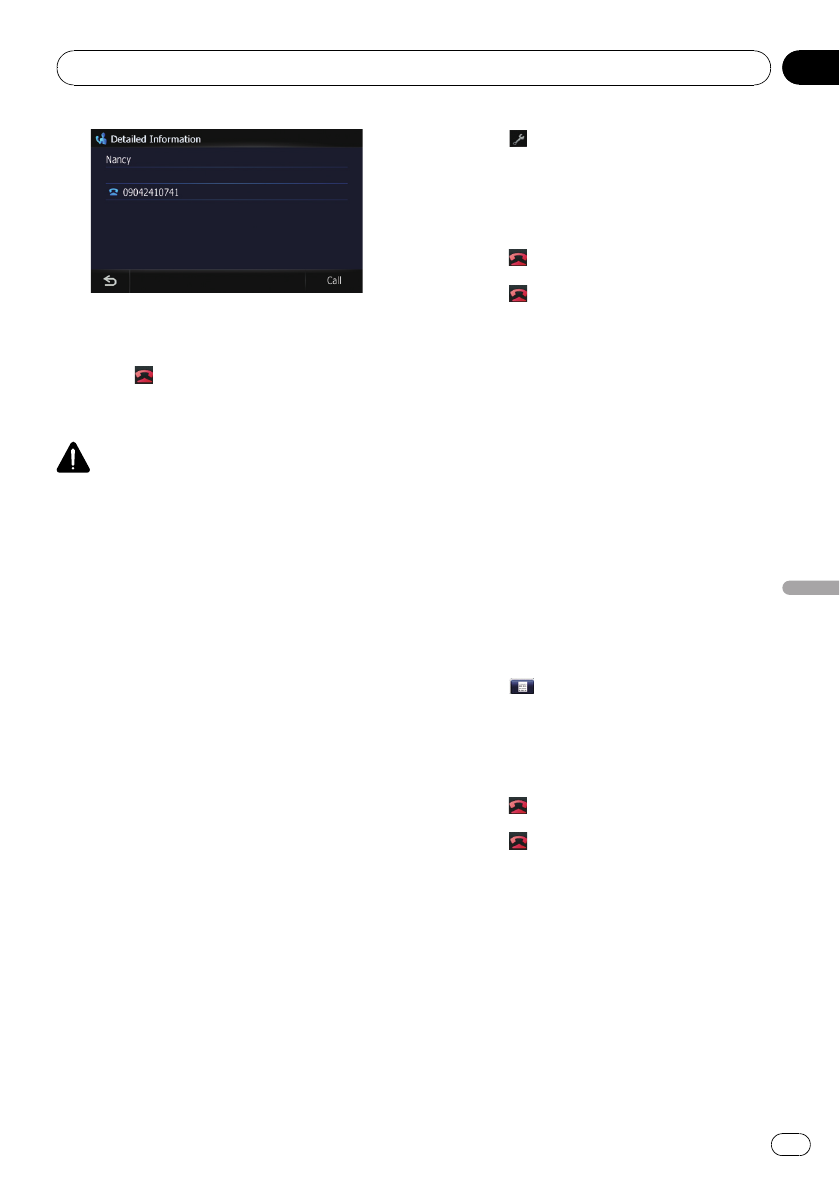
You can check the details of the party before mak-
ing a phone call.
4 Touch to end the call.
Dialing GOOG-411
CAUTION
Local and/or long distance charges for making a
phone call may apply.
You can dial GOOG-411 to dial the free busi-
ness listing service of Googleäwith one
touch.
1 Touch [GOOG-411] on the “Phone
Menu”.
=For details, refer to Displaying the Phone
Menu on page 80.
Dialing GOOG-411 starts.
2 You can now use the GOOG-411 phone
service.
For details about GOOG-411 service and avail-
ability, contact Googleä.
Dialing the entry in the
“Address Book”
You can make a call to the entry registered in
the “Address Book”.
1 Display the “Destination Menu”screen.
2 Touch [Address Book].
The “Address Book List”screen appears.
3 Touch next to the location that you
want to make a call.
The “Address Book Edit”screen appears.
4 Touch [Call] to make a call.
To cancel the call after the system starts dial-
ing, touch .
5 Touch to end the call.
Dialing a facility’s phone number
You can make a call to facilities with phone
number data.
pYou cannot make a call to locations or POIs
that have no phone number data.
1 Display the “Destination Menu”screen.
2 Touch [POI].
The “POI Search”screen appears.
3 Search for the POI.
The “POI List”screen appears.
=For details concerning operations, refer to
Searching for Points of Interest (POI) on
page 58.
4 Touch .
The “Detailed POI Information”screen ap-
pears.
5 Touch [Call] to make a call.
To cancel the call after the system starts dial-
ing, touch .
6 Touch to end the call.
Dialing from the map
You can make a call by selecting the icon of a
registered location or a POI icon from the map
screen.
pYou cannot make a call to locations or POIs
that have no phone number data.
1 Scroll the map, and place the cursor on
an icon on the map.
Using hands-free phoning
En 83
Chapter
12
Using hands-free phoning
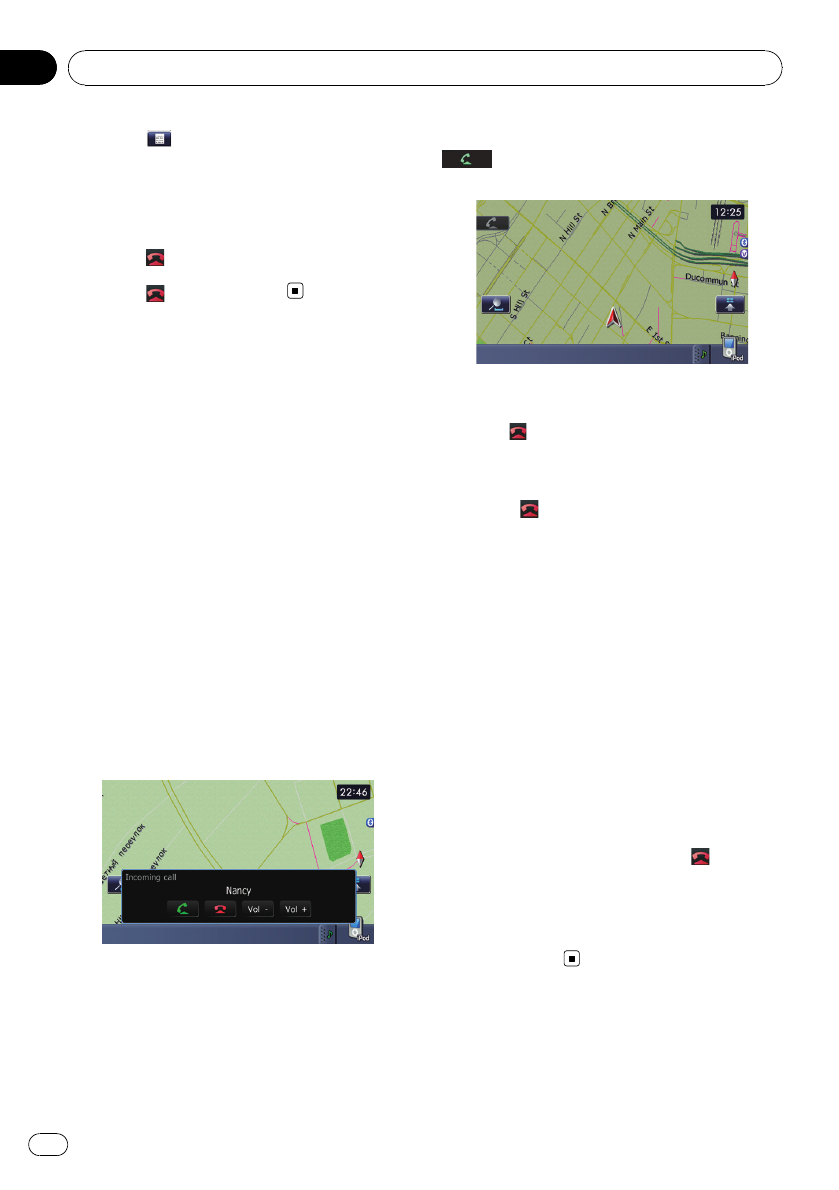
2 Touch .
The “Detailed POI Information”screen ap-
pears.
3 Touch [Call] to make a call.
To cancel the call after the system starts dial-
ing, touch .
4 Touch to end the call.
Receiving a phone call
You can perform hands-free answering by
using the navigation system.
Answering an incoming call
The system informs you that it is receiving a
call by displaying a message and producing a
ring sound once.
If [Auto Answer Preference] is set to [Off],
answer the call manually. Answering is avail-
able if any screen is displayed, such as the
map screen or the setting screen.
pYou can set this navigation system to auto-
matically answer incoming calls.
=For details, refer to Answering a call
automatically on page 86.
1 When a call comes in, the answering
operation menu appears on the screen.
pThe registered name appears if the phone
number of the received call is already regis-
tered in “Contacts”.
pDepending on the caller ID service, the
phone number of the received call may not
be displayed. “Unknown”appears instead.
2 To answer an incoming call, touch
.
New translation required.
#Touch [Vol -]or[Vol +].
You can adjust volume when you are talking.
#Touch to reject an incoming call.
#New translation required.
New translation required.
3 Touch to end the call.
The call ends.
pIf the voice on the other end of the call is
too quiet to hear, you can adjust the volume
of the received voice.
=For more details about “Phone Vo-
lume”, refer to Setting the Volume for
Guidance and Phone on page 96.
pYou may hear a noise when you hang up
the phone.
Rejecting an incoming call
You can reject an incoming call.
=For details, refer to Registering your Blue-
tooth devices on page 76.
%When a call comes in, touch .
The call is rejected.
pThe rejected call is recorded in the missed
call history list.
=For details, refer to Editing the device name
on page 86.
Transferring the phone book
You can transfer the numbers in a registered
user phone’s address book into the Contacts.
Using hands-free phoning
En
84
Chapter
12
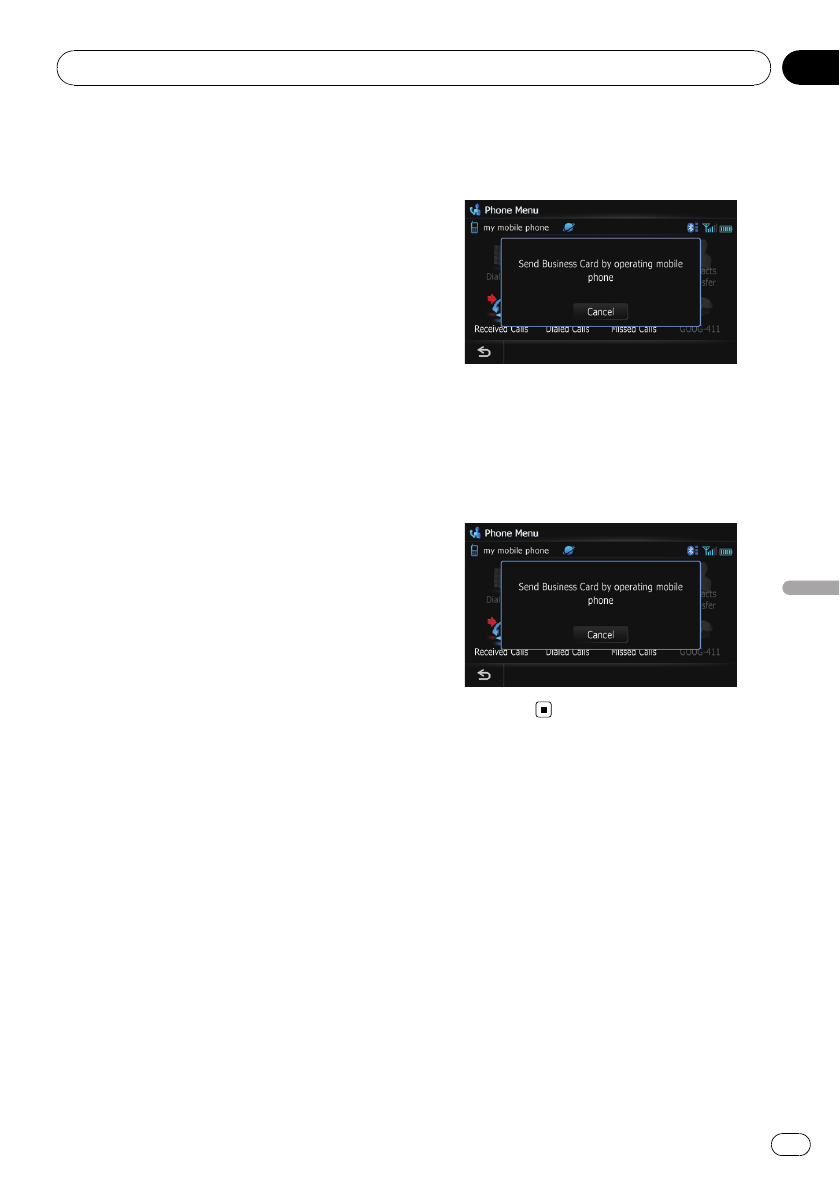
pDepending on the cellular phone, “Phone
Book”may be called a name such as “Con-
tacts”,“Business card”or something else.
pWith some cellular phones, it may not be
possible to transfer the entire phone book
at once. In this case, transfer addresses
one at a time from your phone book using
your cellular phone.
pThe maximum 1 000 entries can be trans-
ferred per cellular phone. If the entries ex-
ceed 1 000, the extra entries will not be
transferred. If more than one number is re-
gistered for one person, such as work place
and home, each number is counted sepa-
rately.
pEach entry can hold up to 5 phone num-
bers.
pDepending on the cellular phone that is
connected to this navigation system via
Bluetooth technology, this navigation sys-
tem may not be able to display the phone
book correctly. (Some characters may be
garbled.)
pIf the phone book in the cellular phone con-
tains image data, the phone book may not
be correctly transferred.
pThe transferred data can not be edited on
the navigation system.
1 Connect the cellular phone that has the
phone book to transfer.
=For details, refer to Connecting a registered
Bluetooth device on page 79.
2 Touch [Contacts Transfer] on the
“Phone Menu”screen.
3 Check that the following screen is dis-
played, and operate your cellular phone to
transfer the phone book entries.
New translation required.
4 Touch [No].
Transfer starts. It may take time depending on
how many entries will be transferred.
5 New translation required.
Transfer ends.
Setting the “Bluetooth
Settings”
To set the “Bluetooth Settings”, display the
“Bluetooth Settings”screen.
1 Press the HOME button to display the
“Top Menu”.
2 Touch [Settings].
The “Settings Menu”screen appears.
3 Touch [Bluetooth Settings].
The “Bluetooth Settings”screen appears.
Using hands-free phoning
En 85
Chapter
12
Using hands-free phoning
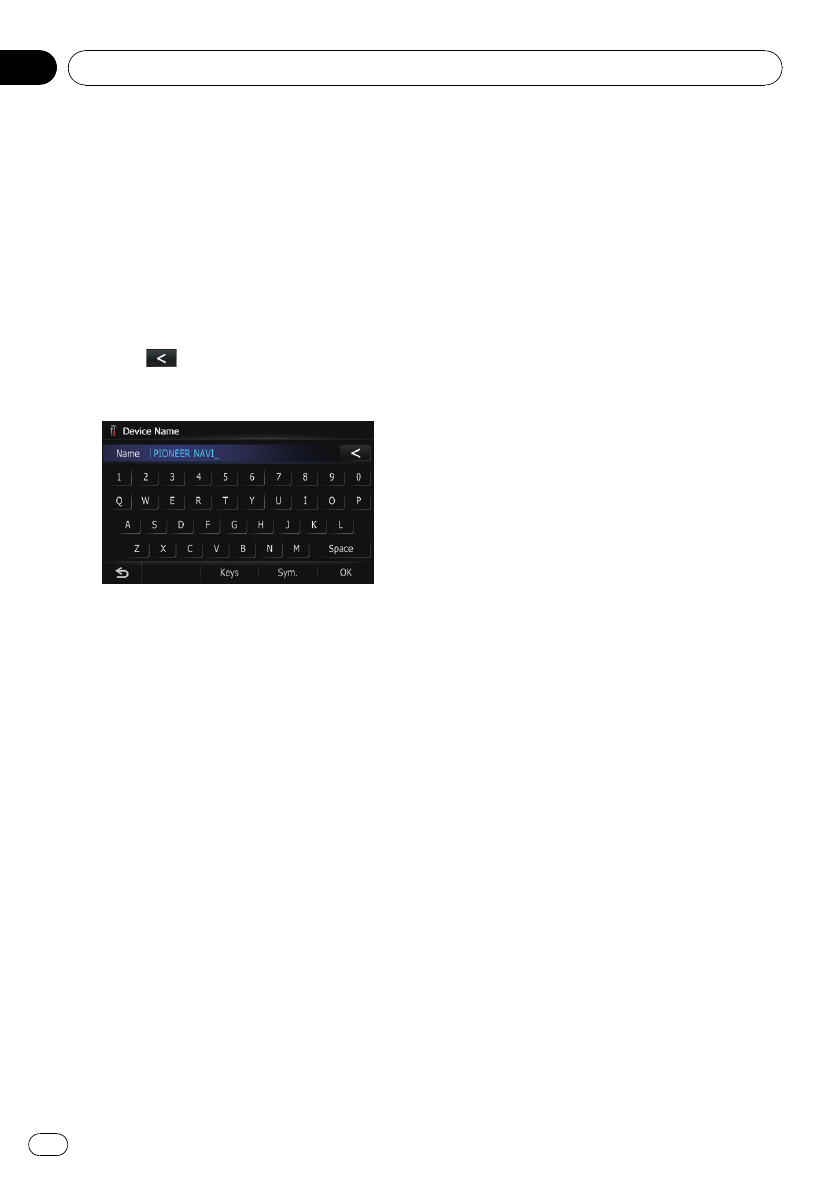
Editing the device name
You can change the device name to be dis-
played on your cellular phone. (Default is
[PIONEER NAVI].)
1 Display the “Bluetooth Settings”
screen.
2 Touch [Device Name].
The keyboard to enter the name appears.
3 Touch to delete the current name,
and enter the new name by using the key-
board.
4 Touch [OK].
The name is changed.
pUp to 16 characters can be entered for a de-
vice name.
Editing the password
You can change the password to be used for
authentication on your cellular phone. (De-
fault is [1111].)
pFour to eight characters can be entered for
a password.
1 Display the “Bluetooth Settings”
screen.
2 Touch [Password].
The “Set Password”screen appears.
3 Touch any key to enter the password
you want to set and then touch [OK].
Stopping Bluetooth wave
transmission
You can stop transmission of electric waves by
turning off the Bluetooth function. If you do
not use the Bluetooth wireless technology, we
recommend selecting [Off].
1 Display the “Bluetooth Settings”
screen.
2 Touch [Bluetooth On/Off].
Touching [Bluetooth On/Off] switching be-
tween [On] and [Off].
Echo canceling and noise reduction
When you are operating hands-free phoning
in the vehicle, you may hear an undesirable
echo. This function reduces the echo and
noise while you are using hands-free phoning,
and maintains a certain sound quality.
1 Display the “Bluetooth Settings”
screen.
2 Touch [Echo Cancel].
Touching [Echo Cancel] switches between
[On] and [Off].
Answering a call automatically
The navigation system automatically answers
incoming calls to the cellular phone, so you
can answer a call while driving without taking
your hands off the steering wheel.
1 Display the “Bluetooth Settings”
screen.
2 Touch [Auto Answer Preference].
The “Auto Answer Preference”screen ap-
pears.
Using hands-free phoning
En
86
Chapter
12
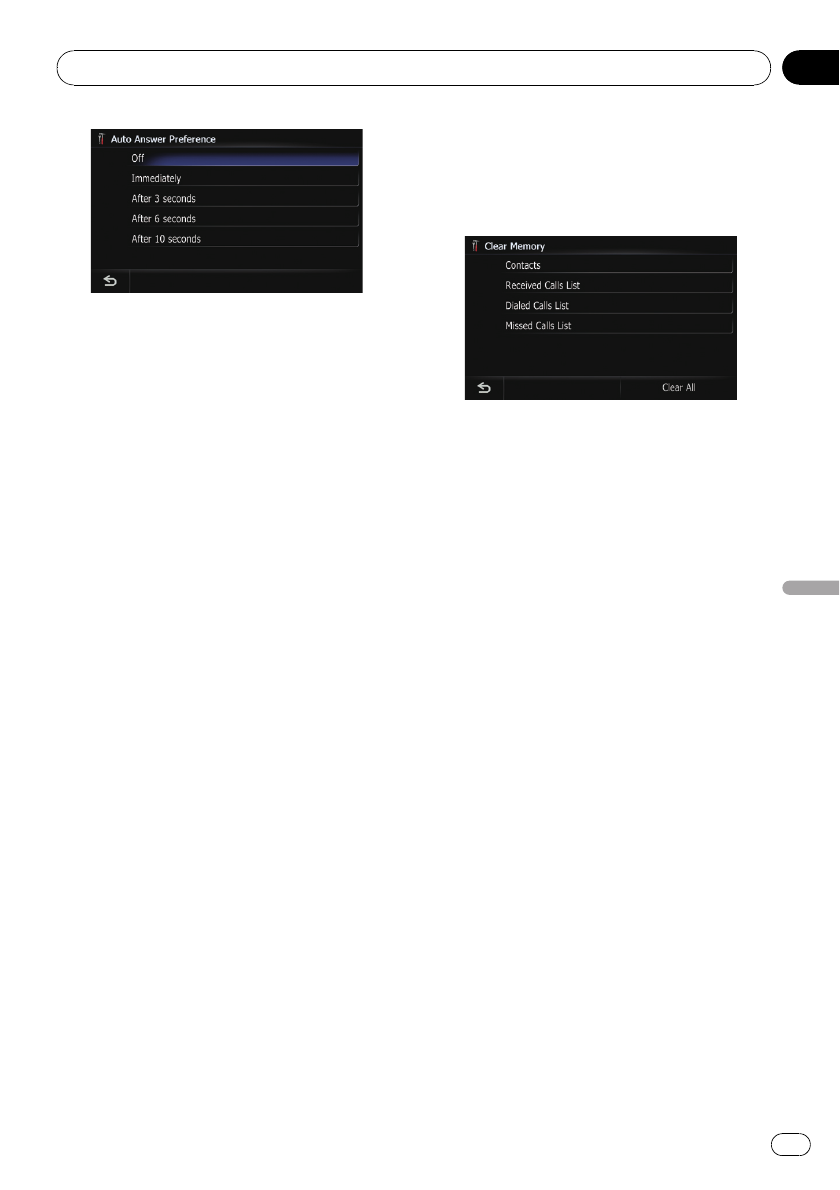
3 Touch the desired option.
![Off]: No automatic response. Respond
manually
![Immediately]: Answers immediately
![After 3 seconds]: Answers after three sec-
onds
![After 6 seconds]: Answers after six sec-
onds
![After 10 seconds]: Answers after ten sec-
onds
Setting the automatic rejection
function
If this function is on, the navigation system
automatically rejects all incoming calls.
1 Display the “Bluetooth Settings”
screen.
2 Touch [Refuse All Calls].
Touching [Refuse All Calls] switches between
[On] and [Off].
pIf both “Refuse All Calls”and “Auto An-
swer Preference”are activated, “Refuse
All Calls”is prioritized and all incoming
calls are automatically rejected.
pIf “Refuse All Calls”is set to [On], rejected
incoming calls will not be stored in the
missed call list.
Clearing memory
You can clear the memory of each item that
corresponds to the connected cellular phone:
phone book, dialed/received/missed call his-
tory list and preset dials.
1 Display the “Bluetooth Settings”
screen.
2 Touch [Clear Memory].
The “Clear Memory”screen appears.
On this screen, you can select the following
items:
!Contacts:
You can clear the registered phone book.
!Received Calls List:
You can clear the received call history list.
!Dialed Calls List:
You can clear the dialed call history list.
!Missed Calls List:
You can clear the missed call history list.
#Touch [Clear All].
It clears all the data that correspond to the con-
nected cellular phone.
3 Touch [OK].
Data on the selected item is cleared from this
navigation system’s memory.
pIf you do not want to clear memory that you
have selected, touch [No].
Updating the Bluetooth
wireless technology software
Update files will be available for download in
the future. You will be able to download the lat-
est update from an appropriate website to
your PC.
pBefore you download the files and install
the update, read through the instructions
on the website. Follow the instructions on
the website for steps until [Firmware Up-
date] becomes active.
Using hands-free phoning
En 87
Chapter
12
Using hands-free phoning
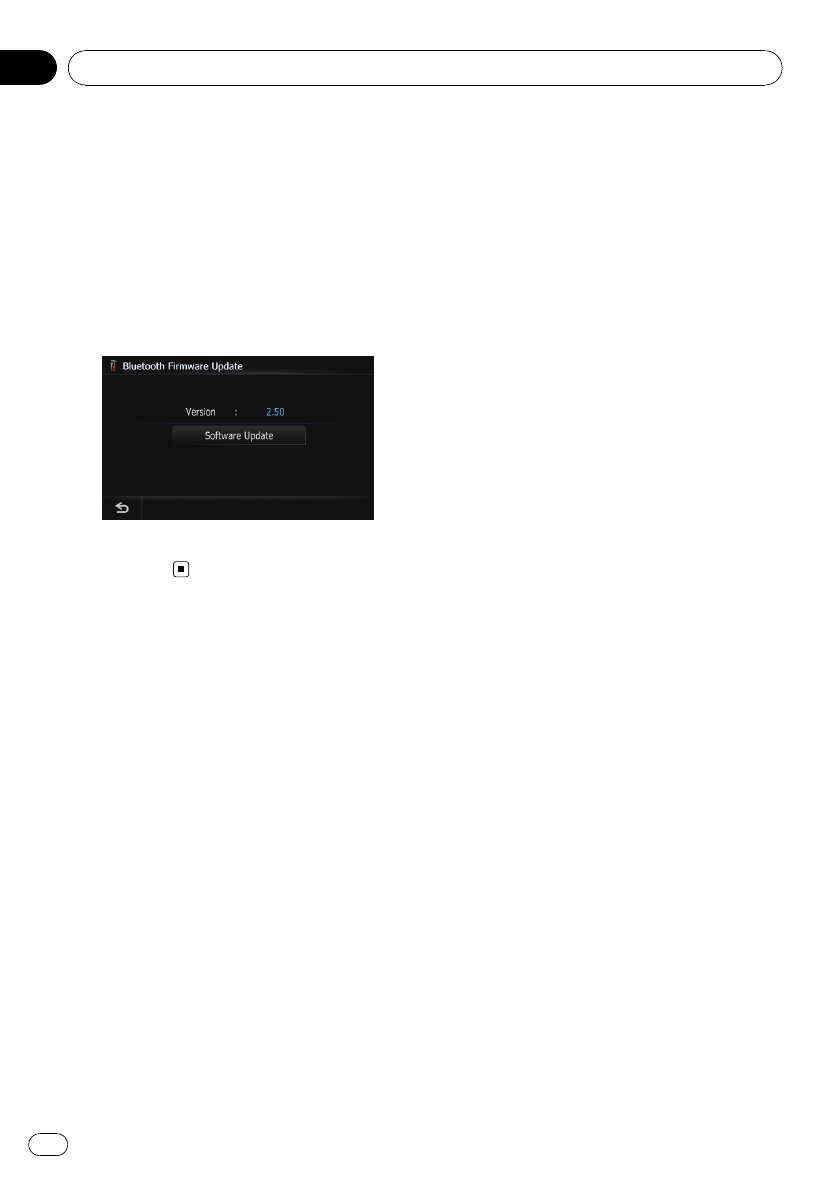
1 Insert an SD memory card into the SD
card slot.
=For more details of the operation, refer to In-
serting and ejecting an SD memory card on
page 29.
2 Display the “Bluetooth Settings”
screen.
3 Touch [Firmware Update].
The current version is displayed.
4 Touch [Firmware Update].
Update starts.
Notes for hands-free phoning
General notes
!Connection to all cellular phones featuring
Bluetooth wireless technology is not guar-
anteed.
!The line-of-sight distance between this na-
vigation system and your cellular phone
must be 10 meters or less when sending
and receiving voice and data via Bluetooth
technology. However, the actual transmis-
sion distance may be shorter than the esti-
mated distance, depending on the usage
environment.
!With some cellular phones, the speakers of
the system may not produce a ring sound.
!If private mode is selected on the cellular
phone, hands-free phoning may be dis-
abled.
Registration and connection
!Cellular phone operations vary depending
on the type of cellular phone. Refer to the
instruction manual that came with your cel-
lular phone for detailed instructions.
!With cellular phones, phone book transfer
may not work even though your phone is
paired with the navigation system. In that
case, disconnect your phone, perform pair-
ing again from your phone to the naviga-
tion system, and then perform the phone
book transfer.
Making and receiving calls
!You may hear a noise in the following situa-
tions:
—When you answer the phone by using
the button on the phone.
—When the person on the other end of
line hangs up the phone.
!If the person on the other end of the phone
call cannot hear the conversation due to an
echo, decrease the volume level for hands-
free phoning. This may reduce the echo.
!With some cellular phones, even if you
press the accept button on the cellular
phone when a call comes in, hands-free
phoning may not be performed.
!The registered name appears if the phone
number of the received call is already regis-
tered in the phone book. When one phone
number is registered under different
names, the name that comes first alphabe-
tically is displayed.
!If the phone number of the received call is
not registered in the phone book, the
phone number of the received call appears.
The received call history and the dialed
number history
!Calls made or editing performed only on
your cellular phone will not be reflected to
the dialed number history or phone book in
the navigation system.
!You cannot make a call to the entry of an
unknown user (no phone number) in the re-
ceived call history.
!If calls are made by operating your cellular
phone, no history data will be recorded in
the navigation system.
Using hands-free phoning
En
88
Chapter
12

Phone book transfers
!If there are more than 1 000 phone book en-
tries on your cellular phone, all entries may
not be able to be downloaded completely.
!With some cellular phones, it may not be
possible to transfer all items in the phone
book at one time. In this case, transfer
items one by one from your cellular phone.
!Depending on the cellular phone, this navi-
gation system may not display the phone
book correctly. (Some characters may be
garbled, or first name and last name may
be in reverse order.)
!If the phone book in the cellular phone con-
tains image data, the phone book may not
be transferred correctly. (Image data can-
not be transferred from the cellular phone.)
!Depending on the cellular phone, phone
book transfer may not be available.
Using hands-free phoning
En 89
Chapter
12
Using hands-free phoning
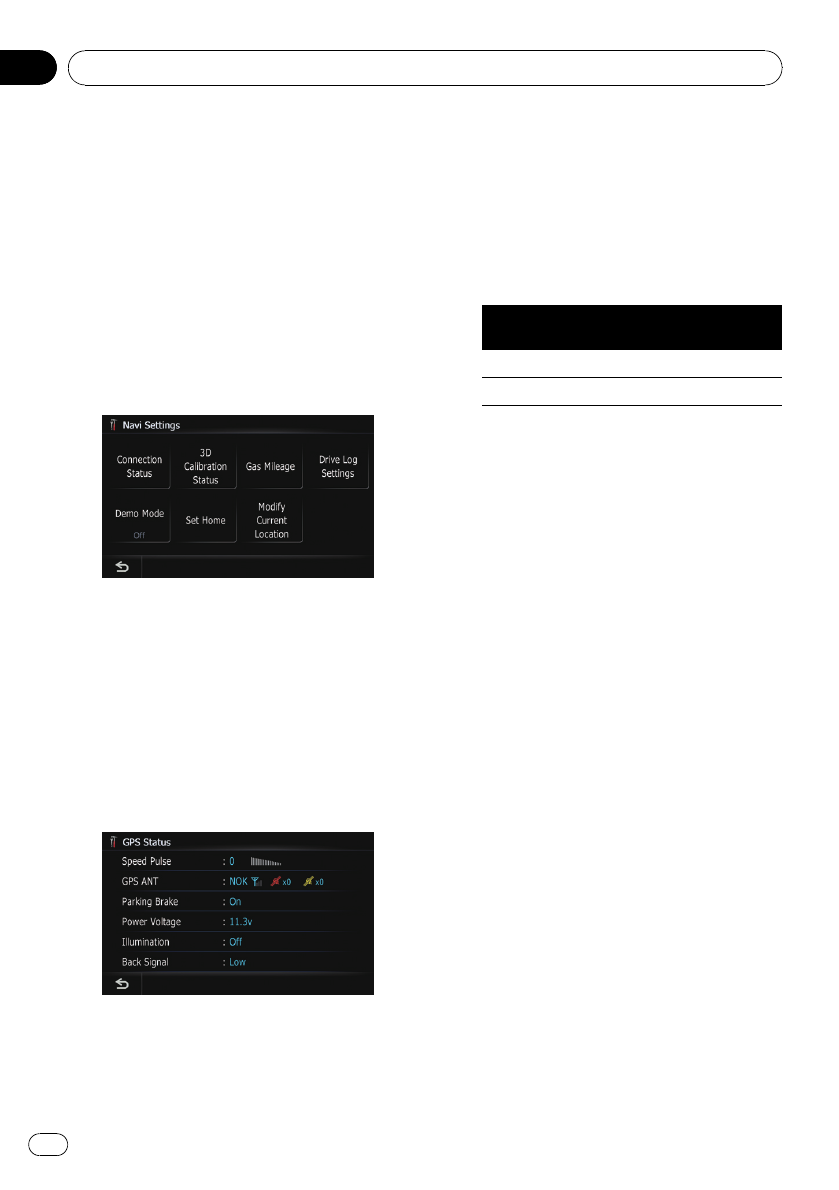
The options in the “Navi
Settings”menu
Displaying the “Navi Settings”
screen
1 Press the HOME button to display the
“Top Menu”.
2 Touch [Settings].
The “Settings Menu”screen appears.
3 Touch [Navi Settings].
The “Navi Settings”menu appears.
Checking the connections of leads
Check that leads are properly connected be-
tween the navigation system and the vehicle.
Please also check whether they are connected
in the correct positions.
1 Display the “Navi Settings”screen.
2 Touch [Connection Status].
The “GPS Status”screen appears.
1Speed Pulse
The Speed Pulse value detected by the navi-
gation system is shown. [0] is shown while
the vehicle is stationary.
2GPS Aerial
Indicates the connection status of the GPS
antenna, the reception sensitivity, and from
how many satellites the signal is received. If
the signal is received correctly, [OK] is dis-
played. If reception is poor, [NOK] appears.
In such case, please change the installation
position of the GPS antenna.
Color Signal com-
munication
Used in posi-
tioning
Orange Yes Yes
Yellow Yes No
3Hand brake
When the parking brake is applied, [On]is
displayed. When the parking brake is re-
leased, [Off] is displayed.
4Power Voltage
The power voltage (reference value) pro-
vided from the vehicle battery to the naviga-
tion system is shown. If the voltage goes
out of the range from 11 V to 15 V, check
that power cable connection is correct.
5Illumination
When the headlights or small lamps of a ve-
hicle are on, [On] is displayed. When the
small lamps of a vehicle are off, [Off] is dis-
played. (If the orange/white lead is not con-
nected, [Off] appears.)
6Back Signal
When the gear lever is shifted to “R”, the
signal switches to [High]or[Low]. (One of
these is displayed depending on the vehi-
cle.)
Checking sensor learning
status and driving status
pThe navigation system can automatically
use its sensor memory based on the outer
dimensions of the tires.
1 Display the “Navi Settings”screen.
2 Touch [3D Calibration Status].
The “3D Calibration Status”screen appears.
Customizing preferences
En
90
Chapter
13

1Distance
Driving distance is indicated.
2Speed Pulse
Total number of speed pulses is indicated.
3Learning Status
Current driving mode is indicated.
4Degree of learning
Sensor learning situations for distance
(Distance), right turn (Right Turn), left turn
(Left Turn) and 3D detection (3D Detec-
tion) are indicated by the length of bars.
pWhen tires have been changed or
chains fitted, turning on the Speed
Pulse allows the system to detect the
fact that the tire diameter has changed,
and automatically replaces the value for
calculating distance.
pIf ND-PG1 is connected, the distance
calculation value cannot be replaced
automatically.
5Speed
The speed detected by the navigation sys-
tem is indicated. (This indication may be
different from the actual speed of your vehi-
cle, so please do not use this instead of the
speedometer.)
6Acceleration or deceleration/Rotational
speed
Acceleration or deceleration velocity of your
vehicle is indicated. Also, rotational speed
when your vehicle turns to left or right is
shown.
7Inclination
Degree of slope of the street that you are
currently running is indicated.
Clearing status
You can delete the learned results stored in
[Distance], [Speed Pulse]or[Learning Sta-
tus].
1 Touch [Distance] or [Speed Pulse].
The following message appears.
2 Touch [Yes].
Clears the learned results stored in [Distance]
or [Speed Pulse].
3 Touch [Learning Status].
The following message appears.
4 Touch [All].
Clears all learning statuses.
pTouch [All] for the following cases:
—After changing the installation position
of the navigation system
—After changing the installation angle of
the navigation system
—After moving the navigation system to
another vehicle
#Touch [Distance].
Clears the learned results stored in [Distance].
pWhen the distance accuracy is low, touch
[Distance].
Using the “Gas Mileage”function
Inputting the fuel consumption
information for calculating the fuel cost
You can estimate the fuel cost to your destina-
tion by entering the fuel consumption informa-
tion in the navigation system.
1 Display the “Navi Settings”screen.
2 Touch [Gas Mileage].
The “Gas Mileage Setting”screen appears.
Customizing preferences
En 91
Chapter
13
Customizing preferences
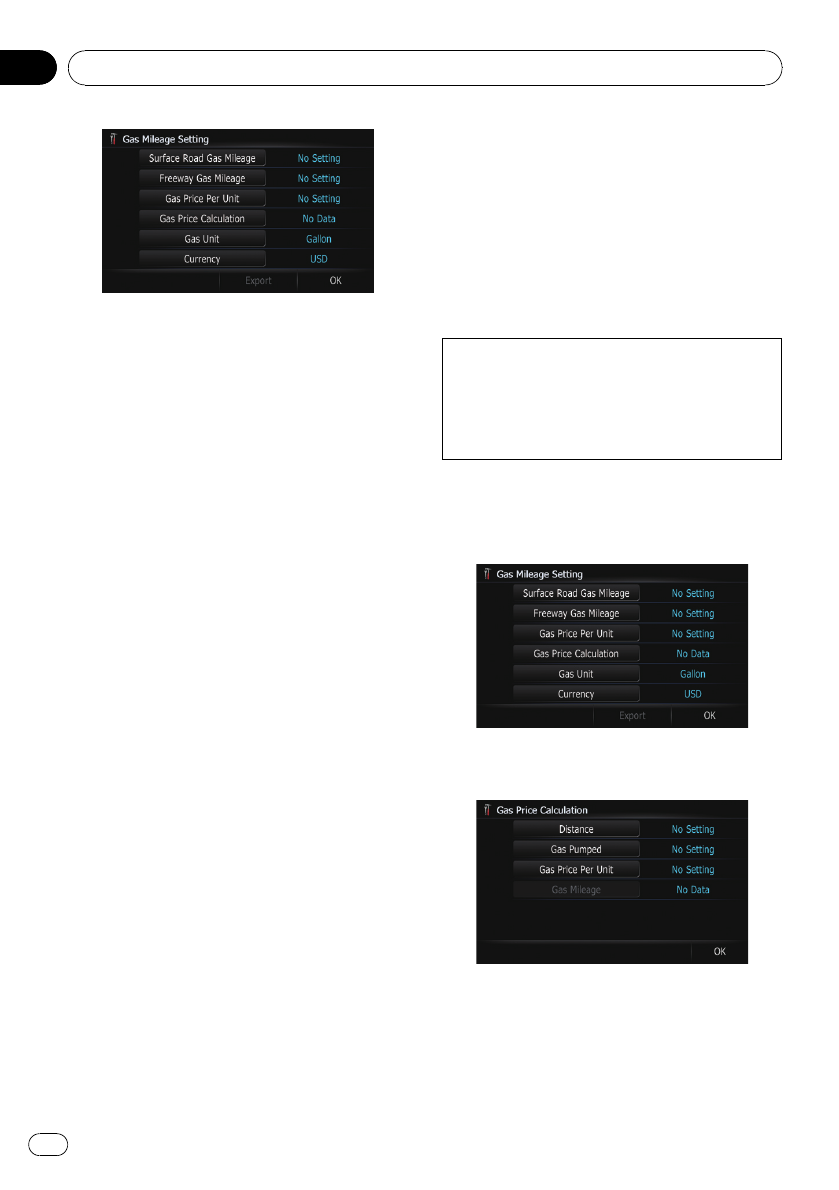
3 Enter the fuel consumption informa-
tion.
Enter the following items:
![Surface Road Gas Mileage]:
Enter the fuel cost when you drive on the or-
dinary road.
pThe entering the fuel cost depends on
the setting of [Gas Unit].
—When [Gas Unit] is set to [Liter].
Enter how much fuel you need to tra-
vel 100 kilometers (60 miles).
—When [Gas Unit] is set to [Gallon].
Enter how many kilometers (miles)
you get to a gallon.
![Freeway Gas Mileage]:
Enter the fuel cost when you drive on the
freeway.
pThe entering the fuel cost depends on
the setting of [Gas Unit].
—When [Gas Unit] is set to [Liter].
Enter how much fuel you need to tra-
vel 100 kilometers (60 miles).
—When [Gas Unit] is set to [Gallon].
Enter how many kilometers (miles)
you get to a gallon.
![Gasl Price Per Unit]:
Enter the fuel unit price.
![Gas Unit]:
Set the fuel unit.
![Currency]:
Set the unit of currency.
When all the items are entered, inputting the
fuel consumption information is complete.
Entering the fueling information
When you enter the fueling information to the
navigation system, and export the data to SD
memory cards, you can check the fuel con-
sumption information by using the utility pro-
gram “NavGate FEEDS”which is available
separately, on your PC.
pUp to 24 sets of “Gas Mileage Manage-
ment”entries can be stored. You can also
export the data, as described below.
If the entries reach the maximum number,
a new entry will overwrite the oldest one.
Gas Mileage Management function only as-
sists you to calculate your average mileage
based on the information you input. The func-
tion does not receive data directly from the ve-
hicle.
1 Display the “Navi Settings”screen.
2 Touch [Gas Mileage].
The “Gas Mileage Setting”screen appears.
3 Touch [Gas Price Calculation].
The “Gas Price Calculation”screen appears.
4 Enter the following settings:
![Distance]:
Enter the distance traveled since the pre-
vious fueling.
Customizing preferences
En
92
Chapter
13

pThe distance is entered automatically
only when the distance traveled since
the previous fueling is recorded.
![Gas Pumped]:
Enter the amount of fuel pumped.
![Gas unit price]:
Enter the fuel unit price.
When all the items are entered, the fuel con-
sumption is displayed next to “Gas Mileage”.
5 Touch [OK].
The “Gas Price Calculation”screen appears.
And then touch [OK] to display the “Gas Mile-
age Setting”screen.
Exporting the data of “Gas Mileage
Management”
Exporting the “Gas Mileage Management”
data to an SD memory card is possible.
pThe data stored in this navigation system
will be cleared as exporting it to the SD
memory card.
1 Insert an SD memory card into the SD
card slot.
=For more details of the operation, refer to In-
serting and ejecting an SD memory card on
page 29.
2 Display the “Destination Menu”screen.
3 Touch [Gas Mileage].
The “Gas Mileage Setting”screen appears.
4 Touch [Export].
After a message confirming whether to export
the data appeared, exporting the data to the
SD memory card starts.
The “Gas Mileage Setting”screen appears
when it is done.
Recording your travel history
Activating the track logger enables you to re-
cord your driving history (called “track log”
below). You can review the travel history later.
pIf an SD memory card is inserted into the
SD card slot, the track logs will be stored in
the SD memory card.
1 Insert an SD memory card into the SD
card slot.
=For more details of the operation, refer to In-
serting and ejecting an SD memory card on
page 29.
2 Display the “Navi Settings”screen.
3 Touch [Drive Log Settings].
The “Drive Log Settings”screen appears.
4 Touch [Drive Log Settings].
Each time you touch the key changes that set-
ting.
![On]:
You can export your track log to the SD
card.
![Off] (default):
You cannot export your track log to the SD
card.
#Touch [Type].
Each time you touch the key changes that set-
ting.
Customizing preferences
En 93
Chapter
13
Customizing preferences
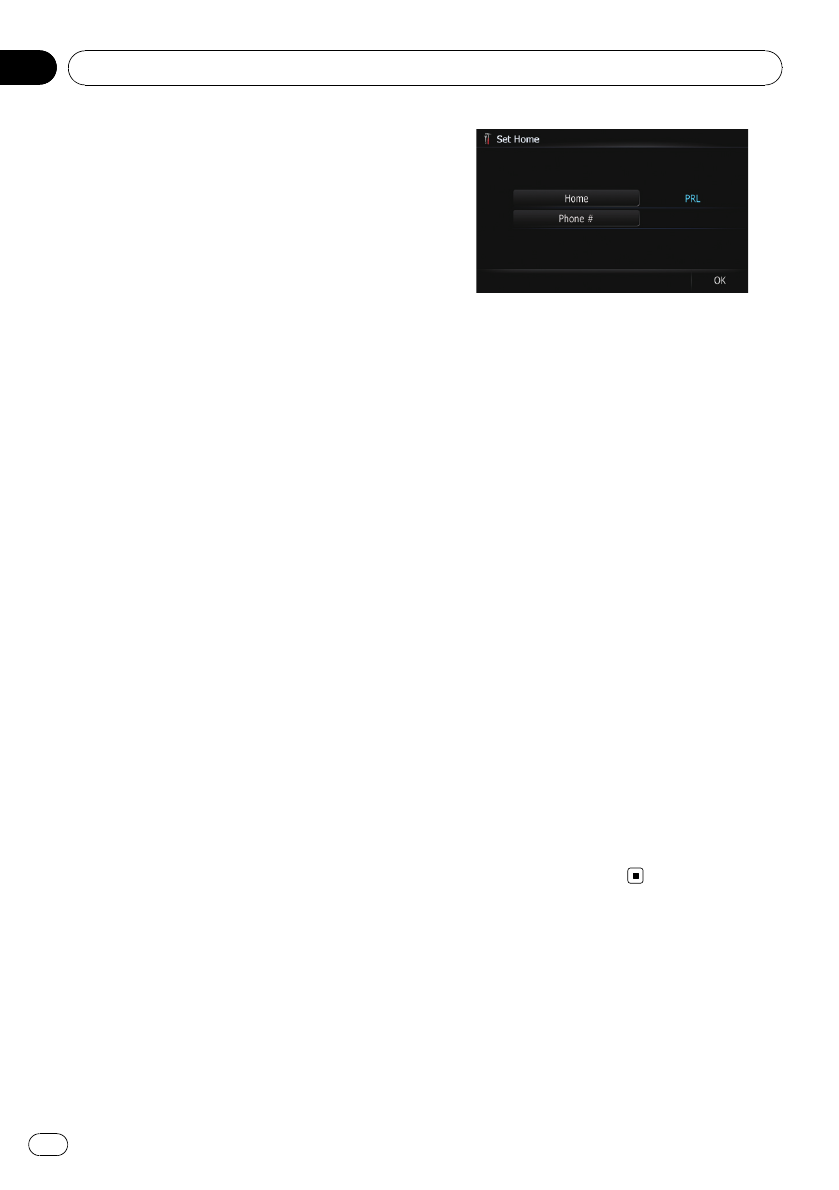
![Private] (default):
Set the track log attribute to “Private”.
![Business]:
Set the track log attribute to “Business”.
![Other]:
Set the track log attribute to “Other”.
pIf you travel while the setting is [On], the
track logs are kept storing in the inserted
SD memory card.
Using the demonstration guidance
This is a demonstration function for retail
stores. After a route is set, touching this key
starts the simulation of route guidance.
1 Display the “Navi Settings”screen.
2 Touch [Demo Mode].
Each time you touch the key changes that set-
ting.
![On]:
Repeat demo drive.
![Off] (default):
Demo Mode is set off.
3 Display the map screen.
The demonstration guidance will begin.
Registering your home
Registering your home position saves time
and effort. Also, routes to home positions can
be calculated easily with a single touch of the
key from the “Destination Menu”. The regis-
tered home position can also be modified
later.
1 Display the “Navi Settings”screen.
2 Touch [Set Home].
The “Set Home”screen appears.
3 Touch [Home].
The “Select Search Method”screen appears.
#Touch [Phone #].
When you have already registered your home,
you can edit your home number.
4 Search for a location.
After searching for a point, display it on a
map, then touch [OK].
The location is registered, and then the “Ad-
dress Book Edit”screen appears.
pFor details, refer to Searching for and select-
ing a location on page 55.
5 Touch [OK].
The registration is completed.
Correcting the current location
Touch the screen to adjust the current position
and direction of the vehicle displayed on the
map.
1 Display the “Navi Settings”screen.
2 Touch [Modify Current Location].
3 Scroll to the position where you want
to set, then touch [OK].
Options on the “System
Settings”menu
Displaying the “System
Settings”screen
1 Press the HOME button to display the
“Top Menu”.
Customizing preferences
En
94
Chapter
13
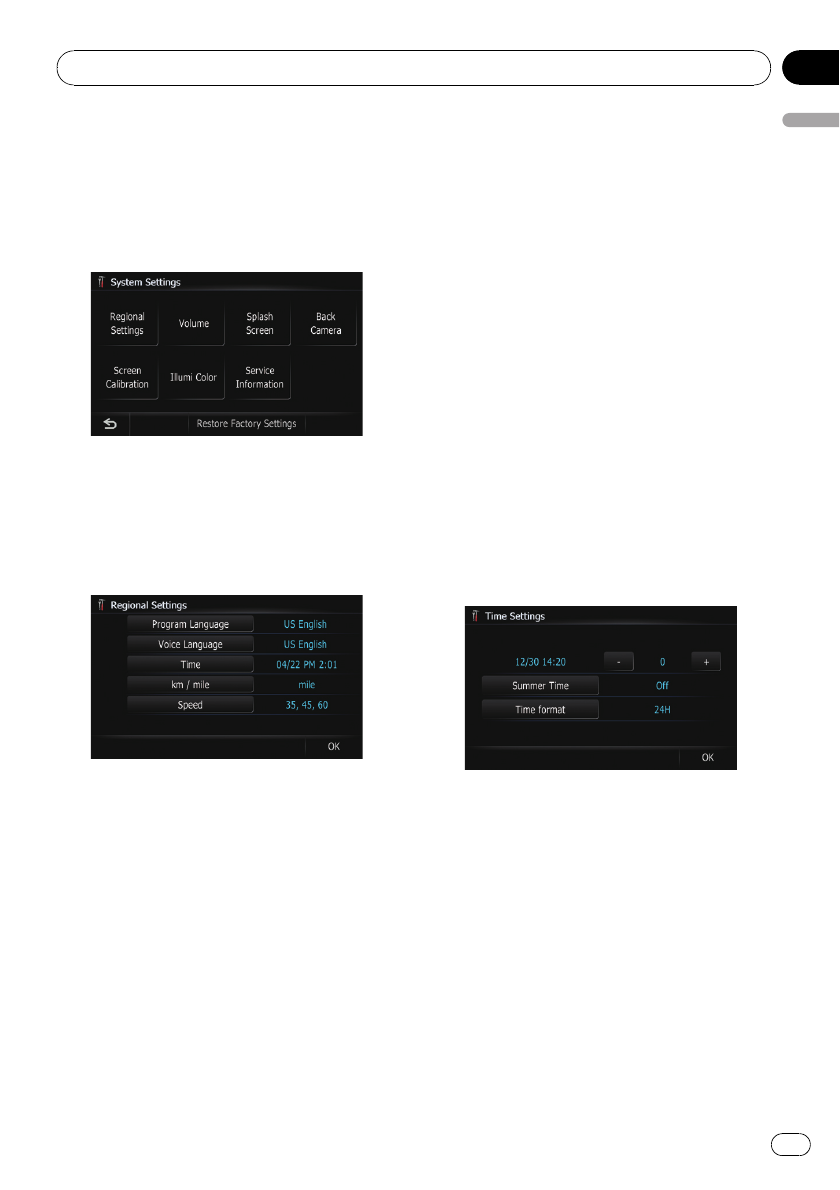
2 Touch [Settings].
The “Settings Menu”screen appears.
3 Display the “Settings Menu”screen.
4 Touch [System Settings].
The “System Settings”screen appears.
Customizing the regional settings
1 Display the “System Settings”screen.
2 Touch [Regional Settings].
The “Regional Settings”screen appears.
Selecting the language
You can set the languages used on the pro-
gram and voice guidance. Each language can
be set separately.
1 Display the “Regional Settings”screen.
2 Touch [Program language].
The language list is displayed.
3 Touch the desired language.
After the language is selected, the screen re-
turns to the previous screen.
4 Touch [Voice language].
The “Voice Language Selection”screen ap-
pears.
5 Touch the desired language.
After the language is selected, the screen re-
turns to the previous screen.
6 Touch [OK] on the “Regional Settings”
screen.
The navigation system restarts.
A message confirming whether to restart the
navigation system appears.
Setting the time difference
Adjusts the systems clock. Set the time differ-
ence (+,–) from the time originally set in your
navigation system.
1 Display the “Regional Settings”screen.
2 Touch [Time].
The “Time Settings”screen appears.
3 To set the time difference, touch [+] or
[–].
The time difference between the time origin-
ally set in the navigation system (Pacific Stan-
dard Time) and the current location of your
vehicle is shown. If necessary, adjust the time
difference. Touching [+]or[–] changes the
time difference display in one-hour incre-
ments.
The time difference can be set from –4to +9
hours.
4 Touch [Summer Time].
If necessary, set to summer time.
Customizing preferences
En 95
Chapter
13
Customizing preferences
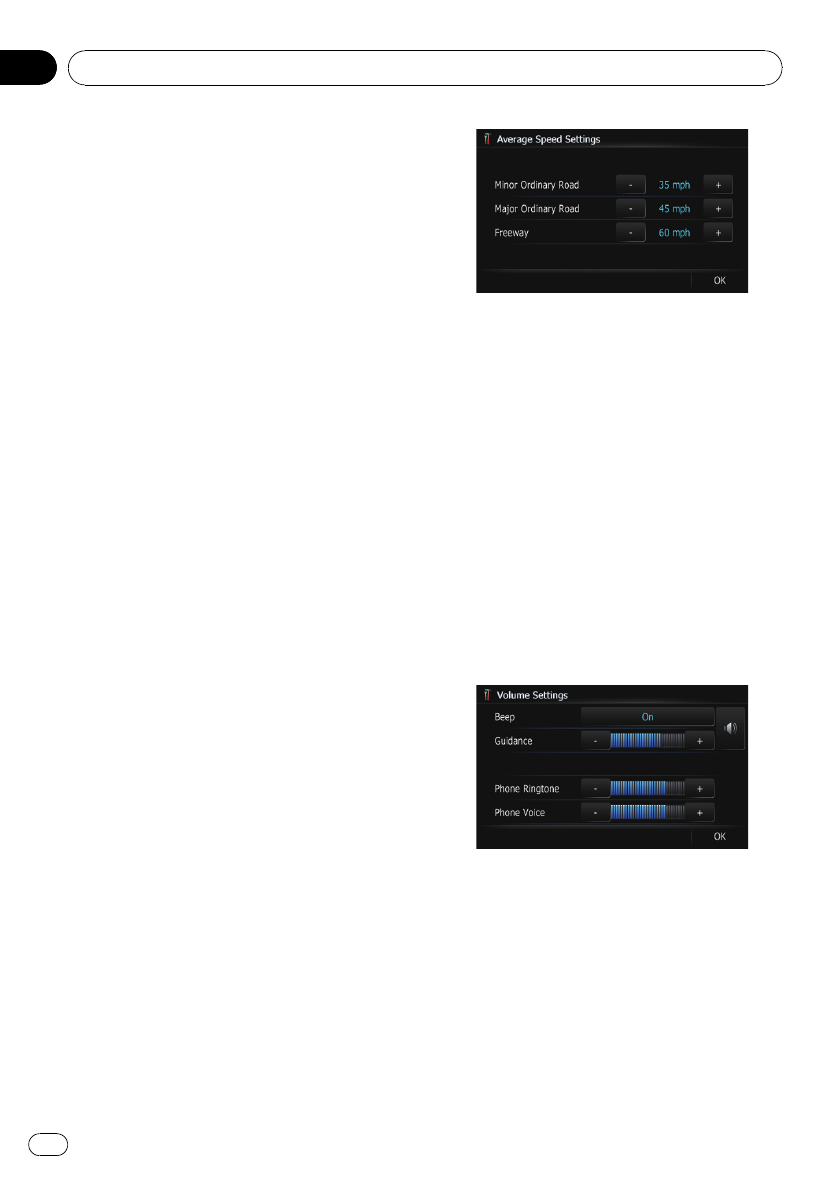
Summer time is off by default. Touch [Sum-
mer Time] to change the time if you are in the
summer time period. This turns the display
below summer time [On].
5 Touch [Time format].
Each time you touch the key changes that set-
ting.
![24H]:
Switching the display for 24 hours.
![12H]:
Switching the display for 12 hours with am/
pm.
Changing the unit between km and miles
This setting controls the unit of distance and
speed displayed on your navigation system.
1 Display the “Regional Settings”screen.
2 Touch [km / mile].
Each time you touch the key changes that set-
ting.
![km] (default):
Show distance in kilometers.
![mile]:
Show distance in miles.
![Mile&Yard]:
Show distance in miles and yards.
Changing the virtual speed of the vehicle
When calculating the expected time of arrival
and the number of hours to the destination,
set the average speed for the freeway or ordin-
ary roads using [+] and [–].
1 Display the “Regional Settings”screen.
2 Touch [Speed].
The “Average Speed Settings”screen ap-
pears.
3 Touch [+] or [–] to set the speed.
pThe estimated time of arrival is not necessa-
rily estimated based on this speed value.
4 Touch [OK].
The settings are completed.
Setting the Volume for
Guidance and Phone
The sound volume for the navigation can be
set. You can separately set the volume of the
route guidance and the beep sound.
1 Display the “System Settings”screen.
2 Touch [Volume].
The “Volume Settings”screen appears.
3 Touch [Beep].
Each time you touch the key changes that set-
ting.
![On] (default):
A beep sounds.
![Off]:
Muting the beep sound.
4 Touch [+] or [–] to set their volume.
On this screen, you can operate the following
items.
Customizing preferences
En
96
Chapter
13

![Guidance]
This setting controls the guidance volume
of navigation.
pWhen set to , guidance is output.
When set to , no guidance is output.
![Phone Ringtone]
This setting controls the incoming ring tone
volume.
![Phone Voice]
This setting controls the incoming voice vo-
lume.
pPhone Ringtone and Phone Voice adjust-
ments are related to the cellular phone fea-
turing Bluetooth technology. No
adjustment is needed when the cellular
phone featuring Bluetooth technology is
not connected.
pVolume of the audio source is adjusted by
VOL (+/–) button of the navigation system.
5 To finish the setting, touch [OK].
Changing the splash screen
You can change the splash screen to the other
images stored in the navigation system.
1 Display the “System Settings”screen.
2 Touch [Splash Screen].
The “Select Splash Screen”screen appears.
3 Touch the image to use as the splash
screen from the list.
The image is displayed on the screen.
4 Touch [OK].
The image is set as the splash screen, and the
system returns to the “System Settings”
menu.
Changing to the splash screen
stored in the SD memory card
You can change the splash screen that ap-
pears when the navigation system starts. Copy
your chosen image to the SD memory card,
and select the image to import.
pSplash screen images should be used with-
in the following formats;
—BMP or JPEG files
—Allowable horizontal and vertical size
are 1944 pixels x 2592 pixels or smaller
—Allowable data size is 6 MB or smaller
pProper compatibility with allowable files is
not guaranteed.
pImported original images will be stored in
the built-in memory, but the ability to save
these images cannot be guaranteed com-
pletely. If your original image data is de-
leted, insert the SD memory card again
and re-import the original image.
1 Create a folder named “PC”on the top-
most directory of the SD memory card, and
then create a folder named “Pictures”on
the “PC”.
2 Store the picture files in “Pictures”.
3 Insert an SD memory card into the SD
card slot.
=For more details of the operation, refer to In-
serting and ejecting an SD memory card on
page 29.
4 Display the “System Settings”screen.
5 Touch [Splash Screen].
The “Select Splash Screen”screen appears.
6 Touch [Import from SD].
The “Splash Screen Selection(SD)”screen ap-
pears.
7 Touch the image to use as the splash
screen from the list.
The image is displayed on the screen.
8 Touch [OK].
The image is set as the splash screen, and the
system returns to the “System Settings”
menu.
Customizing preferences
En 97
Chapter
13
Customizing preferences
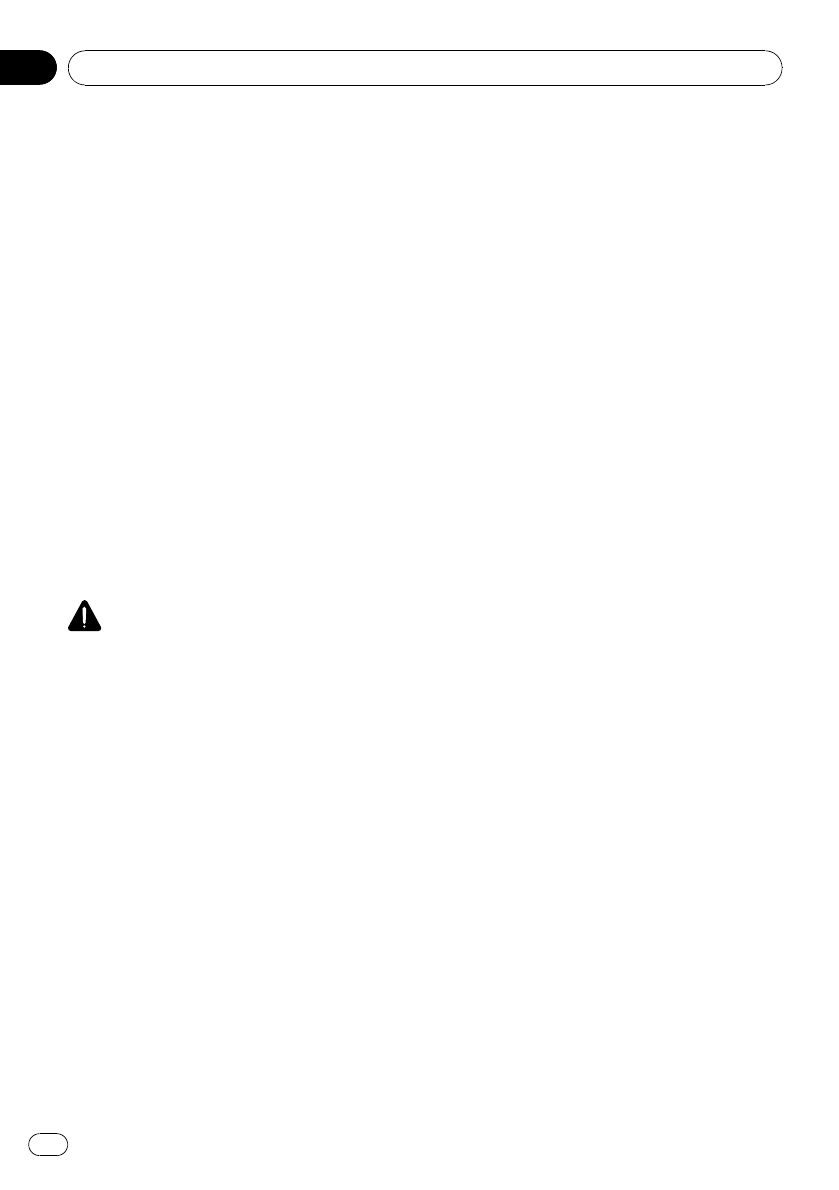
Setting for rear view camera
The following two functions are available. The
rear view camera feature requires a separately
sold rear view camera (e.g. ND-BC2). (For de-
tails, consult your dealer.)
Rear view camera
The navigation system features a function that
automatically switches to the full-screen rear
view camera image installed on your vehicle.
When the shift lever is in the REVERSE (R) po-
sition, the screen automatically switches to
full-screen rear view camera.
Camera for Rear view mode
[Rear View] can be displayed at all times (e.g.
when monitoring an attached trailer, etc.) as a
split screen where map information is partially
displayed. Please be aware that with this set-
ting, camera image is not resized to fit, and
that a portion of what is seen by the camera is
not viewable.
CAUTION
Pioneer recommends the use of a camera which
outputs mirror reversed images, otherwise the
screen image may appear reversed.
pImmediately verify whether the display
changes to a rear view camera image when
the shift lever is moved to REVERSE (R)
from another position.
pWhen the screen changes to full-screen
rear view camera image during normal
driving, switch to the opposite setting in
[Polarity].
1 Display the “System Settings”screen.
2 Touch [Back Camera].
The “Back Camera Settings”screen appears.
3 Touch [Camera] to turn it [On].
pYou can only switch to “Rear View”if this
setting is [On].
4 Touch [Battery] or [GND] next to
“Polarity”to select the appropriate polarity
setting.
!Battery —When the polarity of the con-
nected lead is positive while the shift lever
is in the REVERSE (R) position
!GND —When the polarity of the connected
lead is negative while the shift lever is in
the REVERSE (R) position
Adjusting the response
positions of the touch panel
(touch panel calibration)
If you feel that the touch panel keys on the
screen deviate from the actual positions that
respond to your touch, adjust the response po-
sitions of the touch panel screen.
pDo not use a sharp pointed tool such as a
ballpoint pen or a mechanical pen, which
could damage the screen.
1 Display the “System Settings”screen.
2 Touch [Screen Calibration].
A message confirming whether to start the ca-
libration appears.
3 Gently touch the center of + mark dis-
played on the screen.
The target indicates the order.
After you touch all marks, the adjusted posi-
tion data is saved.
pDo not turn off the engine while saving the
adjusted position data.
#Press the MODE button.
Returns to the previous adjustment position.
#Press and hold the MODE button.
Cancels the adjustment.
Setting the illumination color
The illumination color can be selected from 11
different colors. Furthermore, the illumination
color can switched between these 11 colors in
order.
Customizing preferences
En
98
Chapter
13
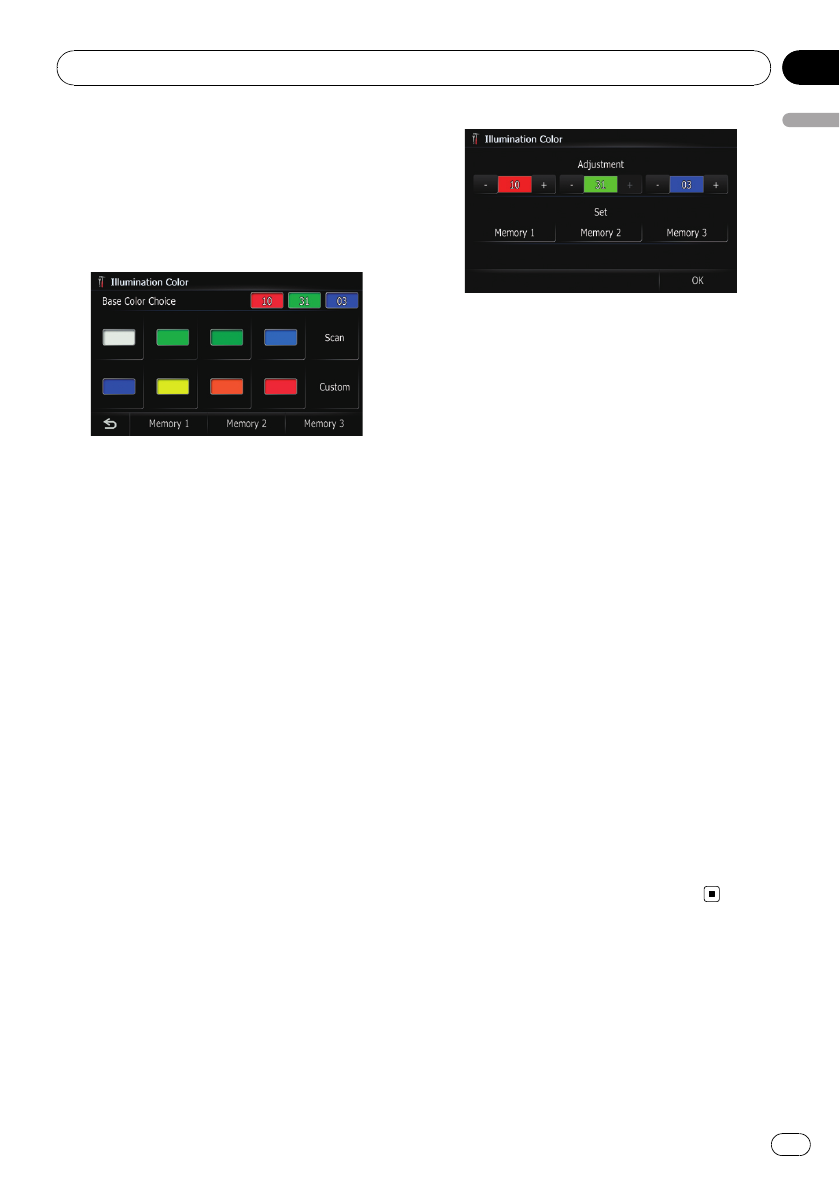
To set the illumination color, display the “Illu-
mination Color”screen.
1 Display the “System Settings”screen.
2 Touch [Illumi Color].
The “Illumination Color”screen appears.
Selecting the color from the preset
colors
1 Display the “Illumination Color”screen.
2 Touch the color you want.
Available options;
!Colored keys —Selects the desired preset
color
!Memory 1/Memory 2/Memory 3 —Col-
ors registered in the memory
=For details, refer to Creating a user-de-
fined color and storing it to memory on
this page.
!Scan —Shifts between the eight default
colors in sequence gradually.
Creating a user-defined color and
storing it to memory
You can create a user-defined color and set it
as the illumination color.
1 Display the “Illumination Color”screen.
2 Touch [Custom].
The “Illumination Color”screen appears.
pIf [Scan] is set, [Custom] cannot be se-
lected.
3 Touch [+] or [-] to adjust the values for
Red, Green and Blue to create a favorite
color.
Watch the illumination of hardware keys while
adjusting the color.
Each time you touch [+]or[-] increases or de-
creases the value of the selected item. +31 to
+00 is displayed as the value is increased or
decreased.
pAn entry cannot be stored with all of the va-
lues set to “+00”.
4 Touch [Memory 1], [Memory 2] or
[Memory 3] to store the illumination color.
5 Touch [OK] to return to the previous
screen.
Checking the version information
1 Display the “System Settings”screen.
2 Touch [Service Information].
The “Service Information Screen”screen ap-
pears.
3 Check the version information.
Replicating the settings
You can import settings you have made on the
utility program “NavGate FEEDS”which is
available separately to the navigation system.
Customizing preferences
En 99
Chapter
13
Customizing preferences

1 Insert an SD memory card into the SD
card slot.
=For more details of the operation, refer to In-
serting and ejecting an SD memory card on
page 29.
2 Press the HOME button to display the
“Top Menu”.
3 Touch [Settings].
The “Settings Menu”screen appears.
4 Touch [Setting Rplctr].
A message confirming whether to update the
settings appears.
5 Touch [Yes].
Update starts.
After updating the settings is finished, a mes-
sage confirming whether to restart the naviga-
tion system appears.
6 Touch [OK].
The navigation system restarts.
Turning off the screen
By turning off the backlight of the LCD screen,
you can turn off the screen display without
turning off the voice guidance.
%Touch [Screen Off] on the “System Set-
tings”menu.
=For details, refer to Display the “Settings
Menu”screen. on page 95.
The screen is turned off.
pTouch anywhere on the screen to turn it
back on.
Customizing preferences
En
100
Chapter
13
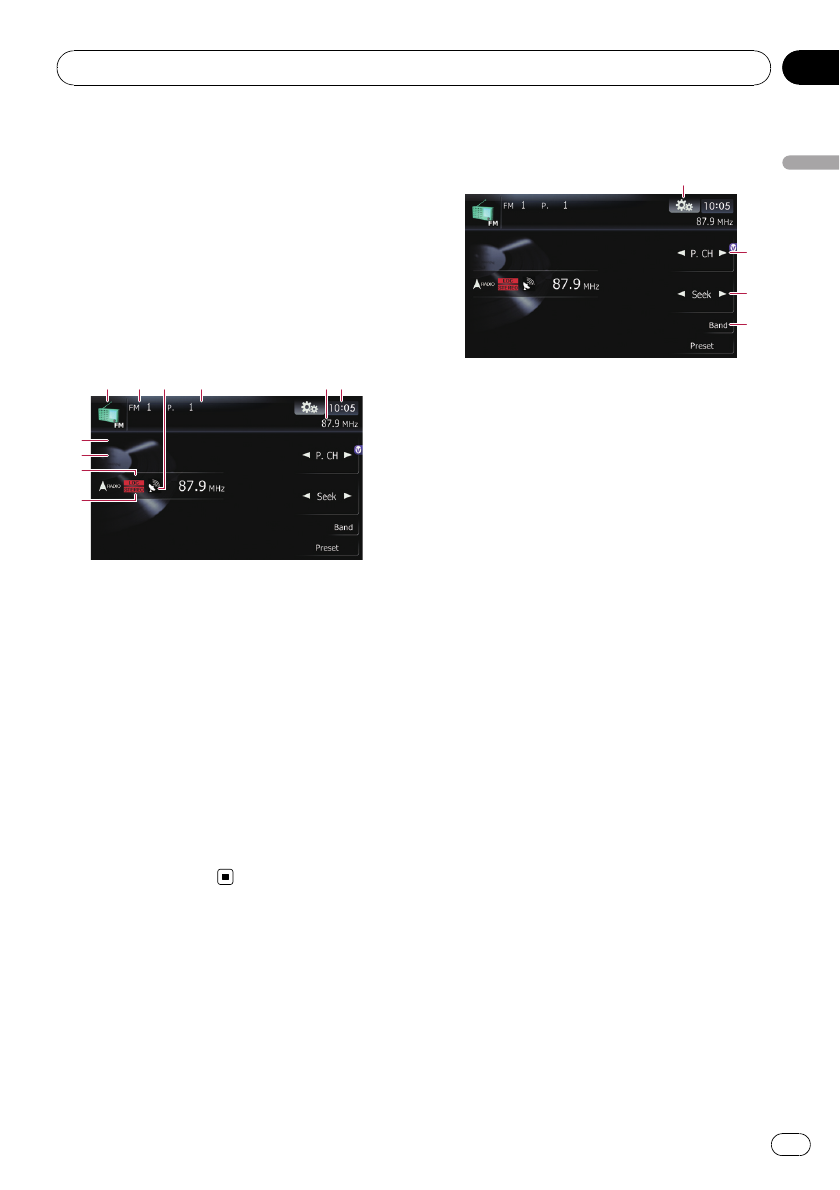
You can listen to the radio by using the naviga-
tion system. This section describes operations
for radio (FM).
%Touch [FM] on the “AV Source”menu to
display the “FM”screen.
=For details concerning operations, refer to
Screen switching overview on page 34.
Reading the screen
1 2 43 6
5
8
7
9
a
1Source icon
Shows which source has been selected.
2Band indicator
Shows which band the radio is tuned to: FM1
to FM3.
3Signal level indicator
4Preset number indicator
Shows what preset item has been selected.
5Frequency indicator
6Current time
7LOCAL indicator
Shows when local seek tuning is on.
8STEREO indicator
Shows that the frequency selected is being
broadcast in stereo.
Using the touch panel keys
2
3
4
1
1Display the “Function”menu
=For details, refer to Using the
“Function”menu on the next page.
2Select a preset channel
[c]or[d] can be used to switch preset chan-
nels.
3Perform manual tuning
To tune manually, touch [c]or[d] briefly. The
frequencies move up or down one step at a
time.
Perform seek tuning
To perform seek tuning, touch and hold [c]or
[d] for about one second and release. The
tuner will scan the frequencies until a broad-
cast strong enough for good reception is
found.
pYou can cancel seek tuning by touching
either [c]or[d] briefly.
pIf you touch and hold [c]or[d], you
can skip broadcasting frequencies.
Seek tuning will start as soon as you re-
lease the keys.
pYou can also perform these operations
by using TRK (c/d) button.
4Select an FM band
Touch [Band] repeatedly until the desired FM
band is displayed, FM1,FM2 or FM3.
pThis function is convenient for preparing
different preset lists for each band.
Using the radio (FM)
En 101
Chapter
14
Using the radio (FM)
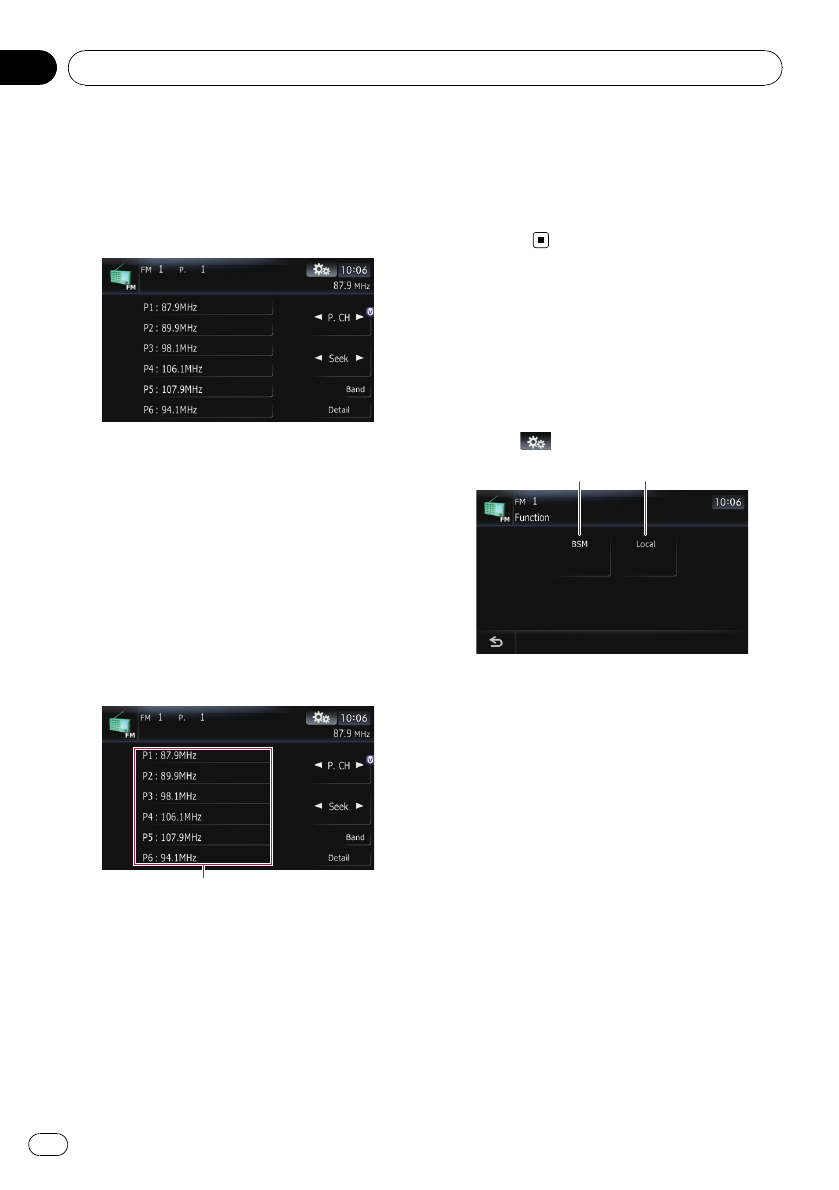
Switching between the
detailed information display
and the preset list display
You can switch the left side of the basic screen
according to your preference.
%Touch [Preset] (or [Detail]).
Each touch of [Preset] (or [Detail]) changes
the detailed information display or preset list
display.
Storing and recalling broadcast
frequencies
With a touch of any of the preset tuning keys
([P1]to[P6]), you can easily store up to six
broadcast frequencies for later recall (also
with the touch of a key).
Preset tuning keys
1 When you find a frequency that you
want to store in memory, touch and hold a
preset tuning key [P1] to [P6] until the pre-
set number (e.g., P. 1) is appears.
The selected radio station has been stored in
memory.
pUp to 18 FM stations, 6 for each of the three
FM bands, as well as 6 AM stations can be
stored in memory.
2 The next time you touch the same pre-
set tuning key [P1] to [P6], the radio station
frequencies are recalled from memory.
pYou can also use [c] and [d] to recall radio
stations assigned to preset tuning keys [P1]
to [P6].
Using the “Function”menu
1 Touch [FM] on the “AV Source”menu to
display the “FM”screen.
=For details concerning operations, refer to
Screen switching overview on page 34.
2 Touch .
1 2
1Storing the strongest broadcast fre-
quencies
=For details, refer to this page.
2Tuning in strong signals
=For details, refer to the next page.
Storing the strongest broadcast
frequencies
“BSM”(best stations memory) lets you auto-
matically store the six strongest broadcast fre-
quencies under the preset tuning keys [P1]to
[P6] and, once stored there, you can tune in to
these frequencies with the touch of a key.
1 Touch [BSM].
Using the radio (FM)
En
102
Chapter
14

2 Touch [Start] to start “BSM”.
BSM begins to flash. While BSM is flashing,
the six strongest broadcast frequencies will be
stored under the preset tuning keys [P1]to
[P6] in order of their signal strength. When
this is complete, BSM stops flashing.
pTo cancel the storage process, touch
[Stop].
pStoring broadcast frequencies with BSM
may replace broadcast frequencies you
have already saved by using [P1]to[P6].
Tuning in strong signals
Local seek tuning allows you to tune in only
those radio stations with sufficiently strong
signals for good reception.
1 Touch [Local].
2 Touch [On] to turn local seek tuning on.
To turn local seek tuning off, touch [Off].
3 Touch [cPrev] or [Nextd] to set the sen-
sitivity.
There are four levels of sensitivity for FM.
Level: 1—2—3—4
pThe level “4”setting allows reception of only
the strongest stations, while lower settings
let you receive weaker stations.
Using the radio (FM)
En 103
Chapter
14
Using the radio (FM)
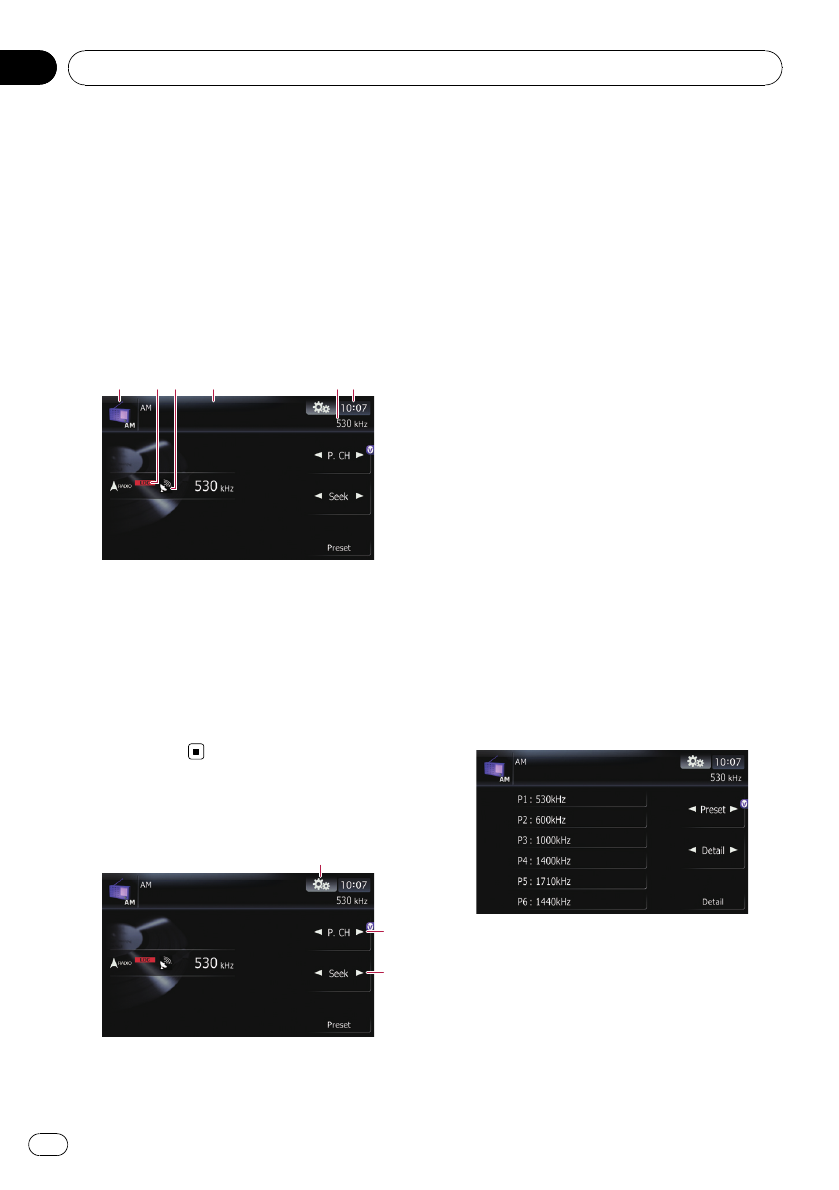
You can listen to the radio using this naviga-
tion system. This section describes operations
for radio (AM).
%Touch [AM] on the “AV Source”menu
to display the “AM”screen.
=For details concerning operations, refer to
Screen switching overview on page 34.
Reading the screen
1 432 65
1Source icon
Shows which source has been selected.
2LOCAL indicator
Shows when local seek tuning is on.
3Signal level indicator
4Preset number indicator
Shows what preset item has been selected.
5Frequency indicator
6Current time
Using the touch panel keys
2
3
1
1Display the “Function”menu
=For details, refer to Using the
“Function”menu on the next page.
2Select a preset channel
cor dcan be used to switch presets.
3Perform manual tuning
To tune manually, touch [c]or[d] briefly. The
frequencies move up or down one step at a
time.
Perform seek tuning
To perform seek tuning, touch and hold [c]or
[d] for about one second and release. The
tuner will scan the frequencies until a broad-
cast strong enough for good reception is
found.
pYou can cancel seek tuning by touching
either [c]or[d] briefly.
pIf you touch and hold [c]or[d], you
can skip broadcasting frequencies.
Seek tuning will start as soon as you re-
lease the keys.
pYou can also perform these operations
by using TRK (c/d) button.
Switching between the
detailed information display
and the preset list display
You can switch the left side of the basic screen
according to your preference.
%Touch [Preset] (or [Detail]).
Each touch of [Preset] (or [Detail]) changes
the detailed information display or preset list
display.
Using the radio (AM)
En
104
Chapter
15
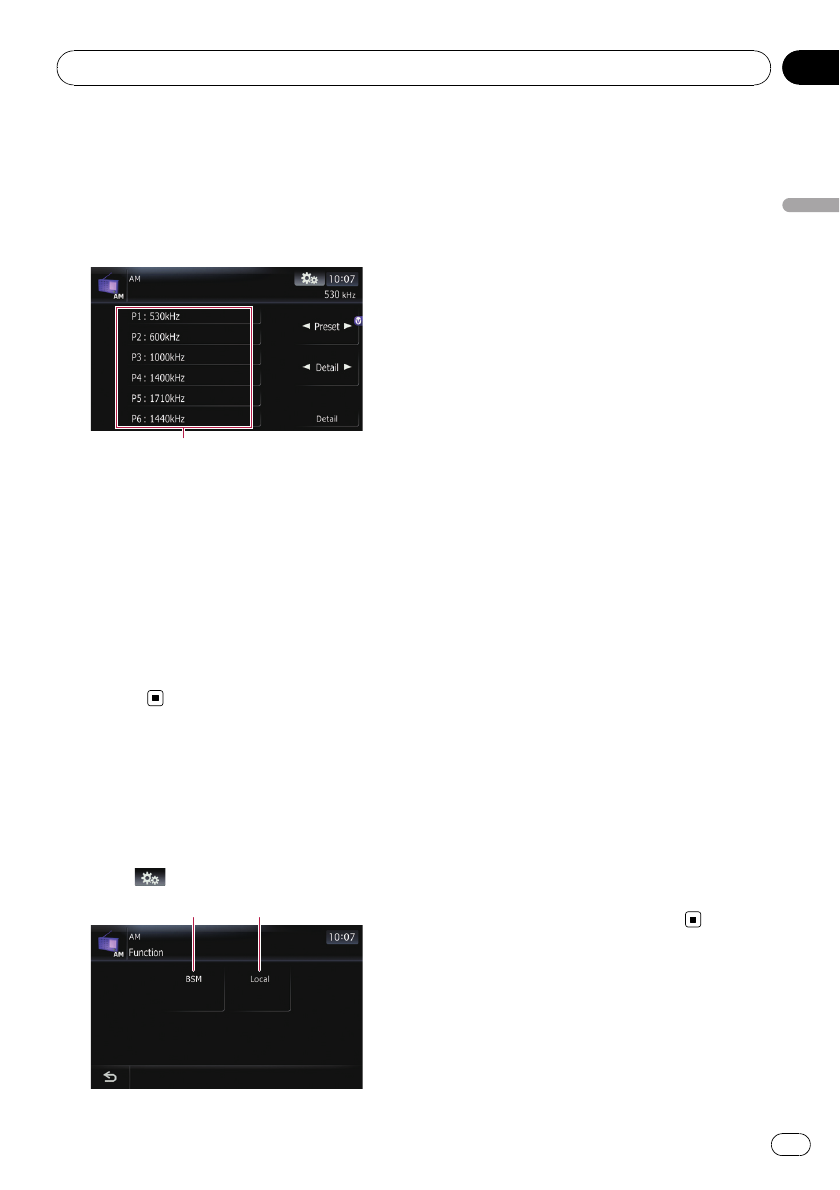
Storing and recalling broadcast
frequencies
With a touch of any of the preset tuning keys
([P1]to[P6]), you can easily store up to six
broadcast frequencies for later recall (also
with the touch of a key).
Preset tuning keys
1 When you find a frequency that you
want to store in memory, touch and hold a
preset tuning key [P1] to [P6] until the pre-
set number (e.g., P. 1) is appears.
The selected radio station has been stored in
memory.
2 The next time you touch the same pre-
set tuning key [P1] to [P6], the radio station
frequencies are recalled from memory.
pYou can also use [c] and [d] to recall radio
stations assigned to preset tuning keys [P1]
to [P6].
Using the “Function”menu
1 Touch [AM] on the “AV Source”menu
to display the “AM”screen.
=For details concerning operations, refer to
Screen switching overview on page 34.
2 Touch .
1 2
1Storing the strongest broadcast fre-
quencies
=For details, refer to this page.
2Tuning in strong signals
=For details, refer to this page.
Storing the strongest broadcast
frequencies
“BSM”(best stations memory) lets you auto-
matically store the six strongest broadcast fre-
quencies under the preset tuning keys [P1]to
[P6] and, once stored there, you can tune in to
these frequencies with the touch of a key.
%Touch [Start] to turn BSM on.
BSM begins to flash. While BSM is flashing,
the six strongest broadcast frequencies will be
stored under the preset tuning keys [P1]to
[P6] in order of their signal strength. When
this is complete, BSM stops flashing.
pTo cancel the storage process, touch
[Stop].
pStoring broadcast frequencies with BSM
may replace broadcast frequencies you
have already saved by using [P1]to[P6].
Tuning in strong signals
Local seek tuning allows you to tune in only
those radio stations with sufficiently strong
signals for good reception.
1 Touch [On] to turn local seek tuning on.
To turn local seek tuning off, touch [Off].
2 Touch [cPrev] or [Nextd] to set the sen-
sitivity.
There are two levels of sensitivity for AM.
Level: 1—2
pThe level “2”setting allows reception of only
the strongest stations, while lower settings
let you receive weaker stations.
Using the radio (AM)
En 105
Chapter
15
Using the radio (AM)
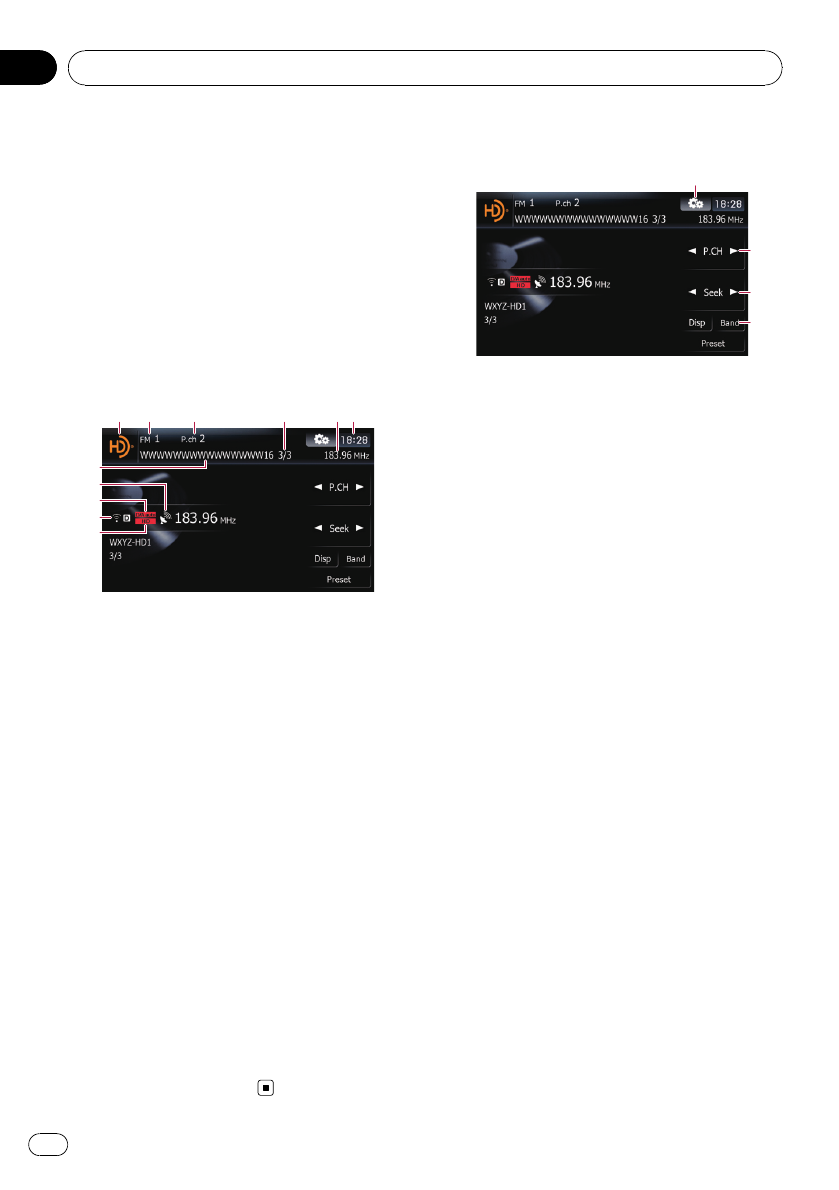
You can listen to the radio by using the naviga-
tion system. This section describes operations
for HD Radioä.
pFor details concerning operation, refer to
the HD Radio tuner’s operation manual.
%Touch [Digital Radio] on the “AV
Source”menu to display the “Digital
Radio”screen.
=For details concerning operations, refer to
Screen switching overview on page 34.
Reading the screen
1
8
9
a
4
b
7
32 65
1Source icon
Shows which source has been selected.
2Band indicator
Shows which band the radio is tuned to: FM1,
FM2, FM3 or AM.
3Preset number indicator
Shows what preset item has been selected.
4Multicasting indicator
Shows the number of multicast channels in
the current frequency.
5Frequency indicator
6Current time
7Detailed information
=For details, refer to Switching the display
on the next page.
8Signal level indicator
9Blending mode indicator
=For details, refer to Switching the re-
ception mode on page 108.
aSignal type indicator
Shows the type of signal currently being re-
ceived. If a digital broadcasting is received,
“D”appears. Otherwise, “A”appears.
bSeek type indicator
=For details, refer to Switching the seek
mode on page 108.
Using the touch panel keys
1
2
3
4
1Display the “Function”menu
=For details, refer to Using the
“Function”menu on the next page.
2Select a preset channel
[c]or[d] can be used to switch presets chan-
nels.
3Perform manual tuning
To tune manually, touch [c]or[d] briefly. The
frequencies move up or down one step at a
time.
Perform seek tuning
To perform seek tuning, touch and hold [c]or
[d] for about one second and release. The
tuner will scan the frequencies until a broad-
cast strong enough for good reception is
found.
pYou can cancel seek tuning by touching
either [c]or[d] briefly.
pIf you touch and hold [c]or[d], you
can skip broadcasting frequencies.
Seek tuning will start as soon as you re-
lease the keys.
pYou can also perform these operations
by using TRK (c/d) button.
4Select a band
Touch [Band] repeatedly until the desired
band is displayed: FM1,FM2,FM3 or AM.
pThis function is convenient for preparing
different preset lists for each band.
Using the HD Radio (Digital Radio)
En
106
Chapter
16
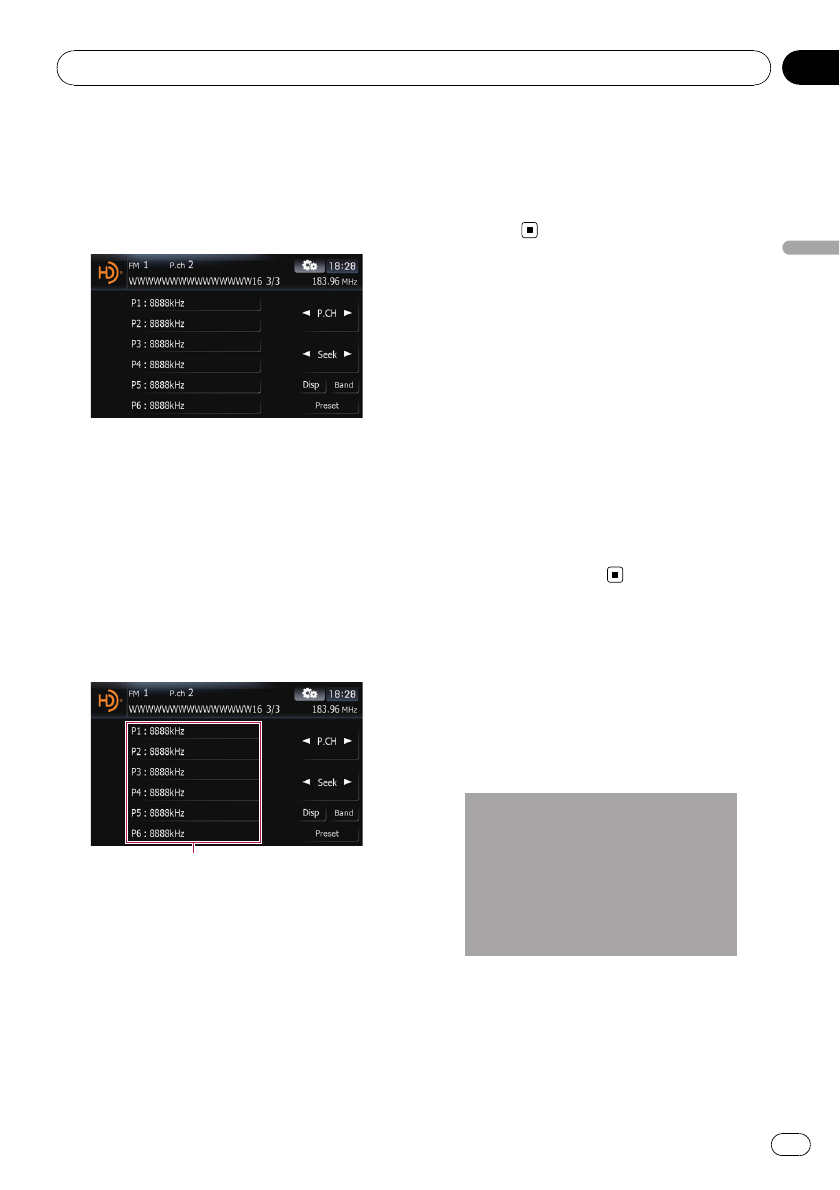
Switching between the
detailed information display
and the preset list display
You can switch the left side of the basic screen
according to your preference.
%Touch [List] (or [Detail]).
Each touch of [List] (or [Detail]) changes the
detailed information display or preset list dis-
play.
Storing and recalling broadcast
frequencies
With a touch of any of the preset tuning keys
([P1]to[P6]), you can easily store up to six
broadcast frequencies for later recall (also
with the touch of a key).
Preset tuning keys
1 When you find a frequency that you
want to store in memory, touch and hold a
preset tuning key [P1] to [P6] until the pre-
set number (e.g., P. 1) stops flashing.
The selected radio station has been stored in
memory.
2 The next time you touch the same pre-
set tuning key [P1] to [P6], the radio station
frequencies are recalled from memory.
pYou can also use [c] and [d] to recall radio
stations assigned to preset tuning keys [P1]
to [P6].
Switching the display
Desired information can be displayed.
%Touch [Disp].
Touch [Disp] repeatedly to switch between the
following settings:
Channel name —Artist name —Song title —
Program type
pOnly when the tuner has been tuned in to
an HD Radio broadcasting, display can be
changed.
pWhen the tuner has been tuned in to an HD
Radio broadcasting, default display is chan-
ged into station name instead of frequency.
#Touch and hold [Disp].
New translation required.
Using the “Function”menu
1 Touch [Digital Radio] on the “AV
Source”menu to display the “Digital
Radio”screen.
=For details concerning operations, refer to
Screen switching overview on page 34.
2 Touch [Func].
1Storing the strongest broadcast fre-
quencies
=For details, refer to the next page.
2Switching the seek mode
=For details, refer to the next page.
3Tuning in strong signals
=For details, refer to the next page.
Using the HD Radio (Digital Radio)
En 107
Chapter
16
Using the HD Radio (Digital Radio)

4Switching the reception mode
=For details, refer to this page.
Storing the strongest broadcast
frequencies
“BSM”(best stations memory) lets you auto-
matically store the six strongest broadcast fre-
quencies under the preset tuning keys [P1]to
[P6] and, once stored there, you can tune in to
these frequencies with the touch of a key.
%Touch [Start] to turn BSM on.
BSM begins to flash. While BSM is flashing,
the six strongest broadcast frequencies will be
stored under the preset tuning keys [P1]to
[P6] in order of their signal strength. When
this is complete, BSM stops flashing.
pTo cancel the storage process, touch
[Stop].
pStoring broadcast frequencies with BSM
may replace broadcast frequencies you
have already saved by using [P1]to[P6].
Switching the seek mode
You can select the method of seek tuning.
%Touch [Seek] to select the desired set-
ting.
![All]:
Seeks stations from both analog and digital
broadcasting.
![HD]:
Seeks from digital broadcasting only.
pIf you select “HD”on this setting while
[Blending] is set to “Analog”, the setting
on [Blending] turns to “Auto”automati-
cally.
Tuning in strong signals
Local seek tuning allows you to tune in only
those radio stations with sufficiently strong
signals for good reception.
1 Touch [On] to turn local seek tuning on.
To turn local seek tuning off, touch [Off].
2 Touch [cPrev] or [Nextd] to set the sen-
sitivity.
There are four levels of sensitivity for FM and
two levels for AM:
FM: 1—2—3—4
AM: 1—2
pThe FM “4”(AM “2”) setting allows recep-
tion of only the strongest stations, while
lower settings let you receive weaker sta-
tions.
Switching the reception mode
If a digital broadcast reception condition gets
poor, the tuner automatically switches to the
analog broadcast of the same frequency level
in default. If you want to prevent a frequent
automatic switching, switch this setting to
[Analog].
%Touch [Blending] to switch the recep-
tion mode.
![Analog]:
Receives analog broadcasting only.
![Auto]:
Automatically switches to the analog broad-
cast of the same frequency level as the digi-
tal broadcast.
pIf you select “Analog”on this setting while
[Seek] is set to “HD”, the setting on [Seek]
turns to “All”automatically.
Using the HD Radio (Digital Radio)
En
108
Chapter
16
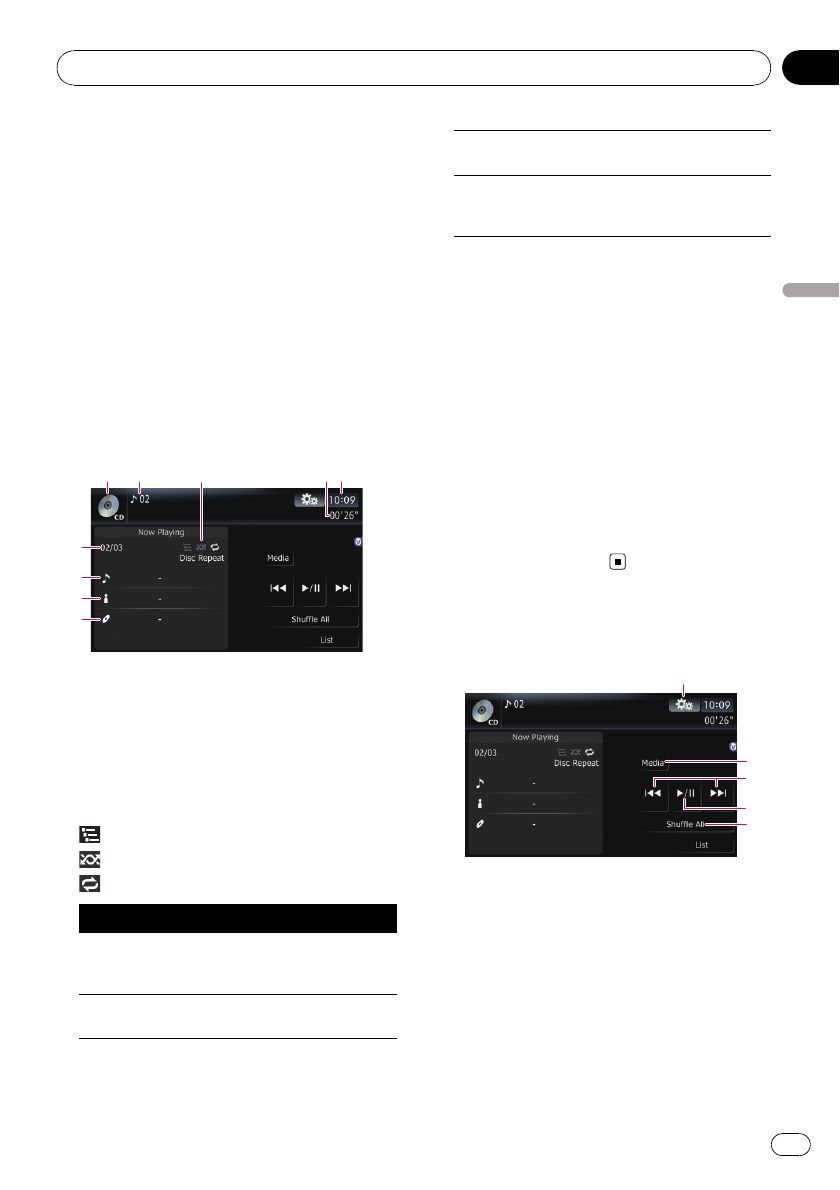
You can play a normal music CD using the
built-in drive of the navigation system. This
section describes how.
1 Insert the disc you want to play into
disc-loading slot.
Playback starts from the first track of the CD.
2 Touch [DISC] on the “AV Source”menu
to display the “CD”screen.
=For details concerning operations, refer to
Screen switching overview on page 34.
3 Use the touch panel keys on the screen
to control the disc.
Reading the screen
1 2 3 54
7
6
8
9
1Source icon
Shows which source has been selected.
2Track number indicator
Shows the number of the track currently play-
ing.
3Playback condition indicator
The marks shown below appears and indi-
cates the current playback condition.
: Scan play
: Random play
: Repeat play
Indicator Meaning
Disc Repeat
All tracks in the current disc
are played repeatedly. This is
the default condition.
Track Repeat The current track is played
repeatedly.
Disc Random All tracks in the current disc
are played in random order.
Disc Scan
The beginning of each track
is played for about 10 sec-
onds.
=For more information, refer to Using the
“Function”menu on page 132.
4Play time indicator
Shows the elapsed playing time within the
current track.
5Current time
6Song number indicator
New translation required.
7Track title indicator
Shows the title of the track currently playing
(when available).
8Artist name indicator
Shows the artist name currently playing
(when available).
9Album title indicator
Shows the title of the album for the current
track (when available).
Using the touch panel keys
Touch panel keys
2
5
3
1
4
1Display the “Function”menu
=For details, refer to Using the
“Function”menu on the next page.
2Switch the media file type played
=For details, refer to Switch the media
file type played on page 112.
3Skip the track forward or backward
Touching [p] skips to the start of the next
track. Touching [o] once skips to the start
of the current track. Touching it again will skip
to the previous track.
Fast reverse or forward
Playing audio CDs
En 109
Chapter
17
Playing audio CDs
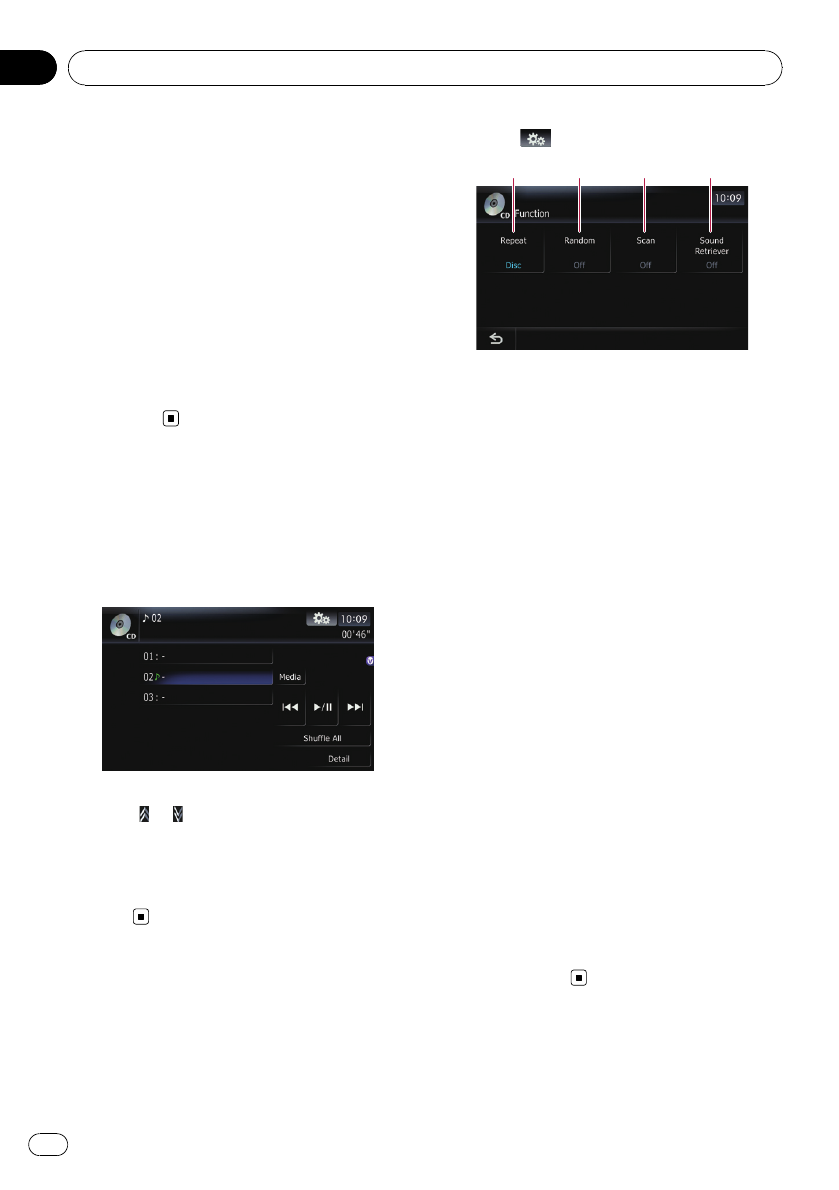
Touch and hold [o]or[p] to fast rewind
or fast forward.
pFast reverse is canceled when it reaches
the beginning of the first track on the
disc.
pYou can also perform these operations
by using TRK (c/d) button.
4Playback and Pause
Touching [f] switches between “playback”
and “pause”.
5Shuffle All
All of the songs in the disc can be played at
random by touching only one key.
pTo cancel random play, switch [Ran-
dom]to[Off] on the “Function”
menu.
Selecting a track from the list
The list lets you see the list of track titles on a
disc and select one of them to play.
1 Touch [List].
2 Touch the track you want to play.
The track currently playing is highlighted.
Touching or switches the selection to the
next or previous page in the list.
pThe “–” mark is displayed if there is no cor-
responding information.
3 To return to the previous screen, touch
[Detail].
Using the “Function”menu
1 Touch [DISC] on the “AV Source”menu
to display the “CD”screen.
=For details concerning operations, refer to
Screen switching overview on page 34.
2 Touch .
1 2 3 4
1Repeating play
Each touch of [Repeat] changes the setting
as follows:
!Disc —Repeats the current disc
!Track —Repeats just the current track
pIf you perform track search or fast for-
ward/rewind, repeat play is automati-
cally canceled.
2Play tracks in a random order
Touching [Random] switches between [On]
and [Off].
3Scan tracks of a CD
Touching [Scan] switches between [On]
and [Off]. Scan play lets you hear the first
10 seconds of each track on the CD. When
you find the track you want, touch [Scan]to
turn scan play off.
pAfter scanning is finished, normal play-
back of the tracks will begin again.
4Using advanced sound retriever
Advanced sound retriever function automa-
tically enhances compressed audio and re-
stores rich sound.
Each touch of [Sound Retriever] changes
the setting as follows:
!Mode 1 —Activates advanced sound
retriever function.
!Mode 2 —Activates advanced sound
retriever function.
!Off —Deactivates advanced sound re-
triever function.
pMODE 2 is more effective than
MODE 1.
Playing audio CDs
En
110
Chapter
17
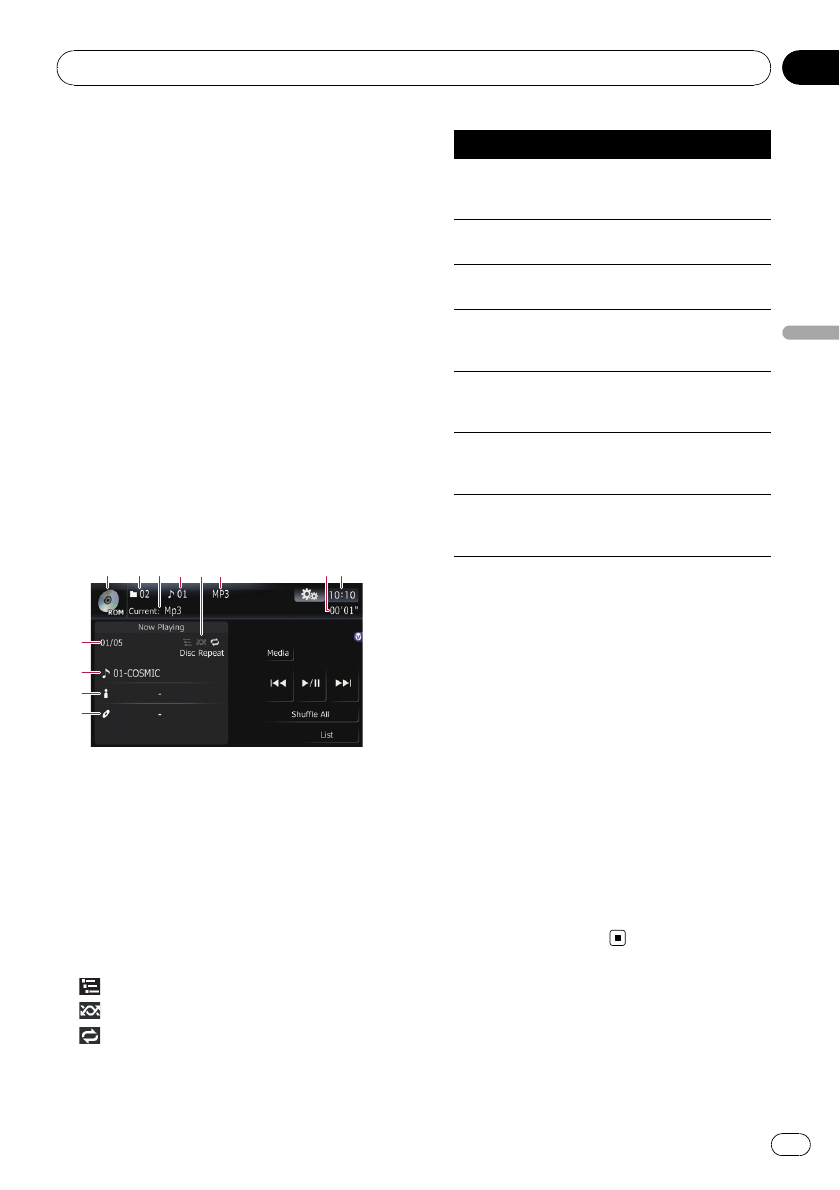
You can play a disc that contains compressed
audio files using the built-in drive of the navi-
gation system. This section describes these
operations.
pIn the following description, the MP3,
WMA, AAC files are collectively referred to
as “Compressed audio file”.
1 Insert the disc you want to play into
disc-loading slot.
Playback starts from the first file of the ROM.
2 Touch [DISC] on the “AV Source”menu
to display the “ROM”screen.
=For details concerning operations, refer to
Screen switching overview on page 34.
3 Use this ROM screen to play the disc.
=For details, refer to Using the touch panel
keys on the next page.
Reading the screen
1 2 3 5 64 8
a
9
7
b
c
1Source icon
Shows which source has been selected.
2Folder number indicator
Shows the folder number currently playing.
3Folder name indicator
Shows the folder name currently playing.
4Track indicator
Shows the track number currently playing.
5Playback condition indicator
The marks shown below appears and indi-
cates the current playback condition.
: Scan play
: Random play
: Repeat play
Indicator Meaning
Disc Repeat
All audio files in the disc are
played repeatedly. This is the
default condition.
Folder Repeat The current folder is played
repeatedly.
Track Repeat The current file is played re-
peatedly.
Disc Random
All audio files in the current
disc are played in random
order.
Folder Random
All audio files in the current
folder are played in random
order.
Disc Scan
The beginning of each audio
file is played for about 10
seconds.
Folder Scan
The beginning of each file in
the current folder is played
for about 10 seconds.
=For more information, refer to Using the
“Function”menu on page 132.
6File type indicator
Shows the type of audio file currently playing.
7Play time indicator
Shows the elapsed playing time within the
current track.
8Current time
9Track number indicator
New translation required.
aTrack title indicator
Shows the title of the track currently playing
(when available).
pNew translation required.
bArtist name indicator
Shows the artist name currently playing
(when available).
cAlbum title indicator
Shows the title of the album for the current
track (when available).
Playing music files on ROM
En 111
Chapter
18
Playing music files on ROM
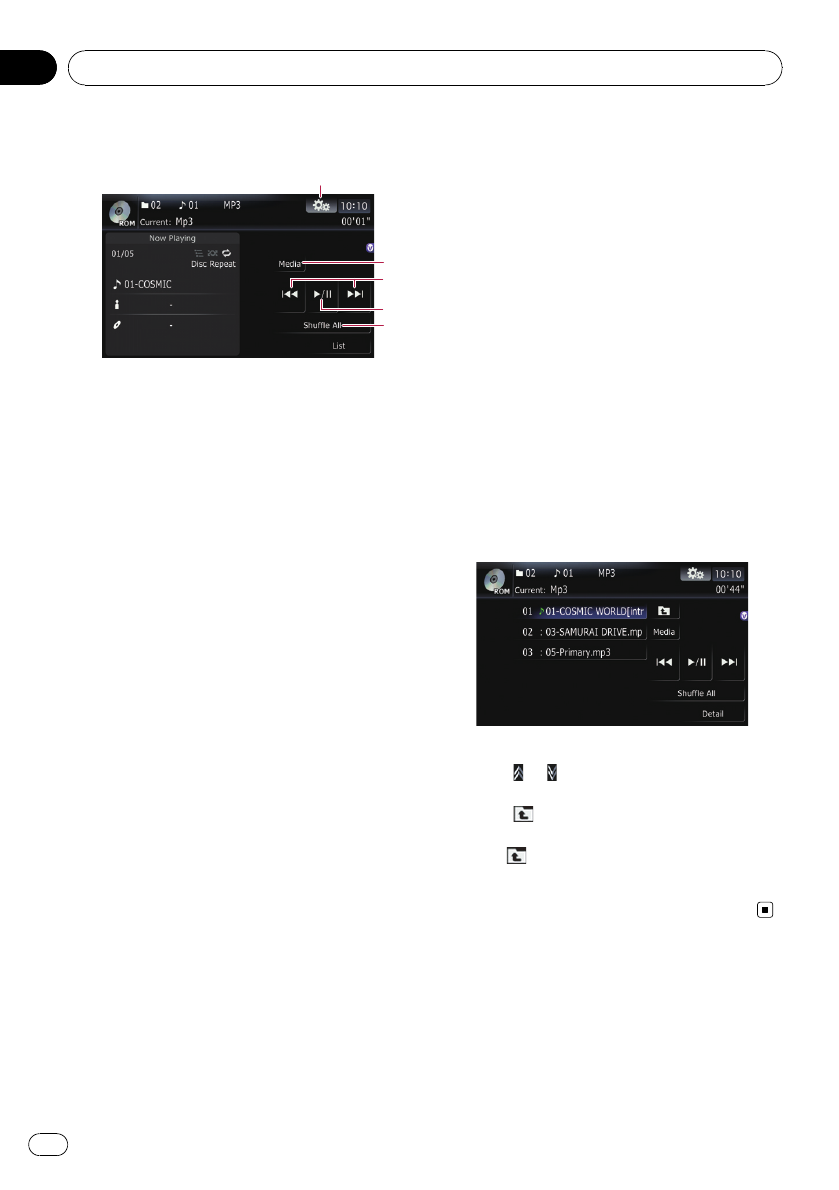
Using the touch panel keys
2
5
3
1
4
1Display the “Function”menu
=For details, refer to Using the
“Function”menu on this page.
2Switch the media file type played
When playing a disc containing a mixture of
various media file types, you can switch be-
tween media files types to play.
Touch [Media] repeatedly to switch between
the following media file types:
CD (audio data (CD-DA)) —ROM (com-
pressed audio file) —DivX (DivX video files)
pThis touch panel key appears only when
playing a disc containing a mixture of
various media file types.
3Skip the track forward or backward
Touching [p] skips to the start of the next
track. Touching [o] once skips to the start
of the current track. Touching it again will skip
to the previous track.
Fast reverse or forward
Touch and hold [o]or[p] to fast rewind
or fast forward.
pFast rewind stops when it reaches the
beginning of the first file on the repeat
range.
pIn the case of compressed audio files,
there is no sound on fast rewind or for-
ward.
pYou can also perform these operations
by using TRK (c/d) button.
4Playback and Pause
Touching [f] switches between “playback”
and “pause”.
5Shuffle All
All of the songs in the disc can be played at
random by touching only one key.
pIf the disc contains a mixture of various
media file types, all tracks within the
current part (“CD”or “ROM”) are played
randomly.
pTo cancel random play, switch [Ran-
dom]to[Off] on the “Function”menu.
Selecting a track from the list
The list lets you see the list of track titles or
folder names on a disc. Touch a folder on the
list to view its contents. You can play a track
on the list by touching it.
1 Touch [List].
Contents of the folder in which the currently
playing file is located are displayed.
2 Touch the folder that you want to view.
The track currently playing is highlighted.
Touching or switches the selection to the
next or previous page in the list.
Touching displays the content of the upper
folder (parent folder). If the uppermost folder
is listed, cannot be used.
3 Touch the track you want to play.
pTo cancel the list screen, touch [Detail].
Using the “Function”menu
1 Touch [DISC] on the “AV Source”menu
to display the “ROM”screen.
=For details concerning operations, refer to
Screen switching overview on page 34.
Playing music files on ROM
En
112
Chapter
18
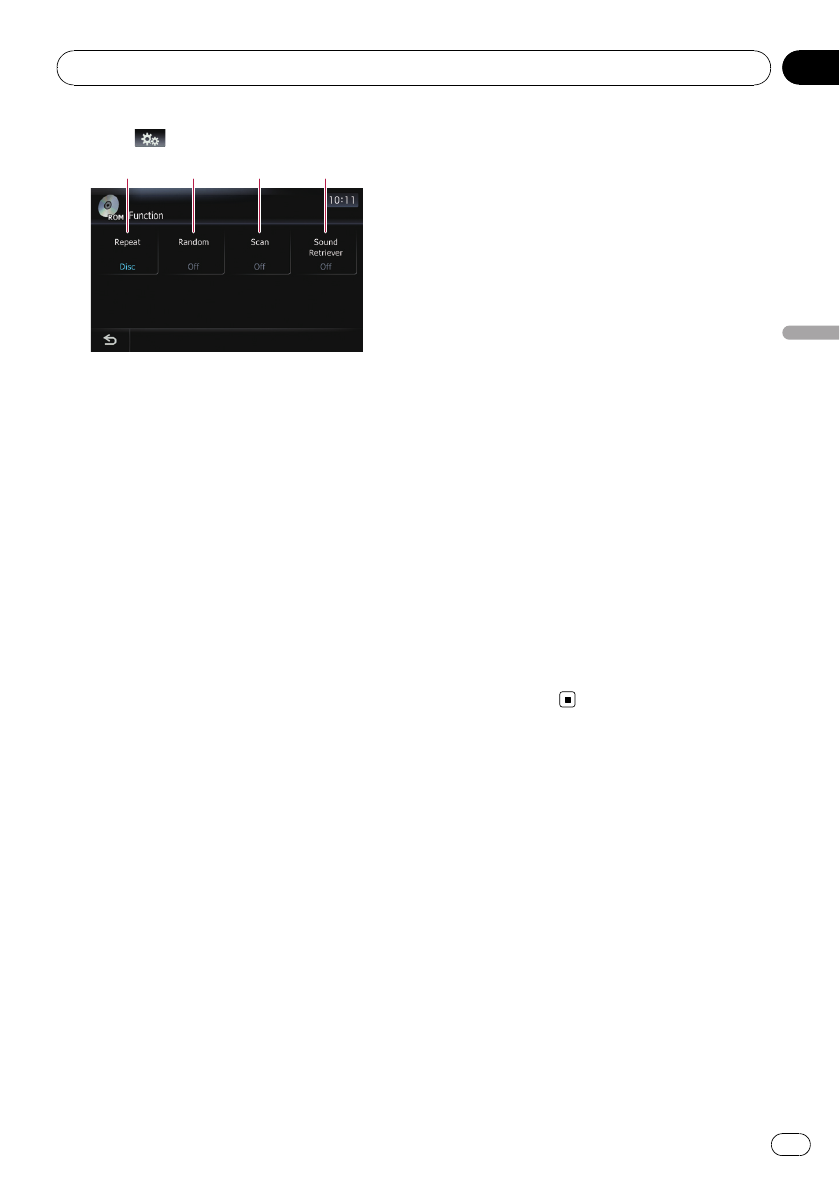
2 Touch .
1 2 3 4
1Repeating play
Each touch of [Repeat] changes the setting
as follows:
!Disc —Repeats all compressed audio
files
!Track —Repeats just the current track
!Folder —Repeats the current folder
pIf you select another folder during repeat
play, the repeat play range changes to
[Disc].
pIf you perform fast forward/rewind dur-
ing [Track], the repeat play range
changes to [Folder].
pWhen [Folder] is selected, it is not pos-
sible to play back a subfolder of that
folder.
pWhen playing discs with compressed
audio files and audio data (CD-DA), re-
peat play is performed within the cur-
rently playing data session even if [Disc]
is selected.
2Play tracks in a random order
Touching [Random] switches between [On]
and [Off]. When using ROM, the tracks in
the current repeat play range are randomly
played.
pIf you turn [Random]to[On] when the
repeat play range is set to [Track], the re-
peat play range changes to [Folder]
automatically.
3Scan folders and tracks
Scan play lets you hear the first 10 seconds
of each track. Scan play is performed in the
current repeat play range.
Touching [Scan] switches between [On]
and [Off]. When you find the track you
want, touch [Scan] to turn scan play off.
pAfter completion of track or folder scan-
ning, normal playback of the tracks will
begin again.
pIf you turn [Scan]to[On] when the re-
peat play range is set to [Track], the re-
peat play range changes to [Folder]
automatically.
pIf you turn [Scan]to[On] while the re-
peat play range is set to [Disc], scan
play is performed for only the first tracks
of each folder.
4Using advanced sound retriever
Advanced sound retriever function automa-
tically enhances compressed audio and re-
stores rich sound.
Each touch of [Sound Retriever] changes
the setting as follows:
!Mode 1 —Activates advanced sound
retriever function.
!Mode 2 —Activates advanced sound
retriever function.
!Off —Deactivates advanced sound re-
triever function.
pMODE 2 is more effective than
MODE 1.
Playing music files on ROM
En 113
Chapter
18
Playing music files on ROM
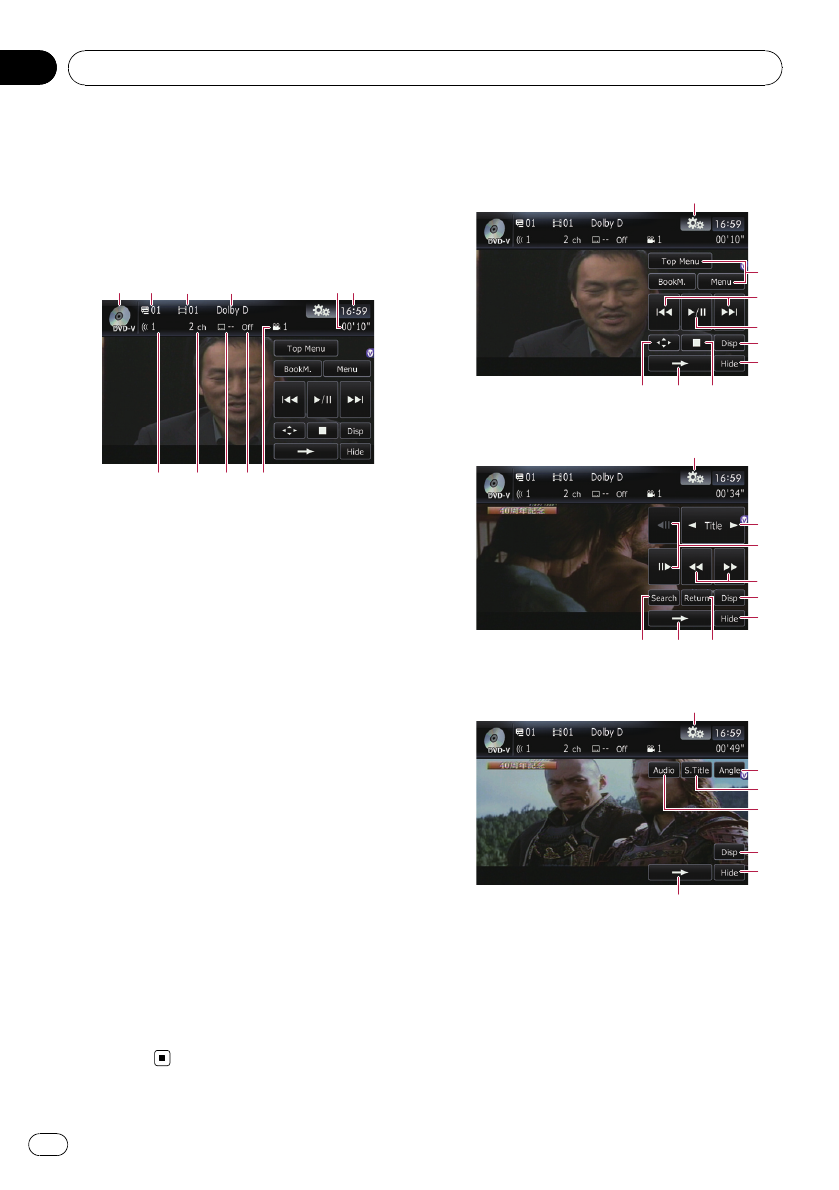
You can play a DVD-Video using the built-in
drive of the navigation system. This section de-
scribes operations for playing a DVD-Video.
Reading the screen
1 2 43 65
879ab
1Source icon
Shows which source has been selected.
2Title number indicator
Shows the title number currently playing.
3Chapter number indicator
Shows the chapter currently playing.
4Digital sound format indicator
Shows which digital sound format (surround
sound format) has been selected.
5Play time indicator
Shows the elapsed playing time within the
current title.
6Current time
7Audio track indicator
Shows the audio track number and audio lan-
guage currently selected.
8Audio channel indicator
Shows the current audio channel type, such
as “Mch”(Multi-channel).
9Subtitle number indicator
Shows the subtitle number currently selected.
aSubtitle language indicator
Shows the subtitle language currently se-
lected.
bViewing angle indicator
Shows what viewing angle has been
selected.
Using the touch panel keys
Playback screen (page1)
2
5
6
87
3
1
9
4
Playback screen (page2)
a
5
6
8d
b
1
e
c
Playback screen (page3)
f
5
6
8
g
1
h
pWith some discs, the icon 9may be dis-
played, meaning that the operation is not
valid.
1Display the “Function”menu
=For details, refer to Using the
“Function”menu on page 117.
2Display the DVD menu
Playing a DVD-Video
En
114
Chapter
19

You can display the menu by touching [Menu]
or [Top Menu] while a disc is playing. Touch-
ing either of these keys again lets you start
playback from the location selected from the
menu. For details, refer to the instructions pro-
vided with the disc.
3Skip forward or backward
Touching [p] skips to the start of the next
chapter. Touching [o] once skips to the
start of the current chapter. Touching it again
will skip to the previous chapter.
pYou can also perform these operations
by using the TRK (c/d) button.
4Playback and Pause
Touching [f] switches between “playback”
and “pause”.
5Switch the display
Touching [Disp] changes the indication on the
information plate as follows:
Disc information display —Repeat range and
L/R select display
6Hide the touch panel keys
Touching [Hide] hides the touch panel keys.
Touch anywhere on the LCD screen to display
the touch panel keys again.
7Display the DVD menu keypad
=For details, refer to Using DVD menu by
touch panel keys on the next page.
8Switch next page of touch panel keys
9Stop playback
aSkip the title forward or backward
Touching [d] skips to the start of the next title.
Touching [c] skips to the start of the previous
title.
bFrame-by-frame playback (or slow-motion
playback)
=For details, refer to Frame-by-frame play-
back on page 117.
=For details, refer to Slow motion playback
on page 117.
cFast reverse or forward
Touch [m]or[n] to perform fast reverse or
forward.
If you touch and hold [m]or[n] for five
seconds, fast reverse/fast forward continues
even if you release either of these keys. To re-
sume playback at a desired point, touch
[f], [m]or[n] opposite to key pushed
for five seconds.
dSearching for a desired scene and starting
playback from a specified time
pFor details, refer to Searching for a speci-
fic scene and starting playback from a
specified time on the next page.
ePerform an operation (such as resuming)
that is stored on the disc
When using a DVD that has a point recorded
that indicates where to return to, the DVD re-
turns to the specified point and begins play-
back from that point.
fChange the viewing angle (Multi-angle)
Each touch of [Angle] switches between view-
ing angles.
pDuring playback of a scene shot from
multiple angles, the angle icon is
displayed. Turn the angle icon display
on or off using the “DVD/DivX® Setup”
menu.
=For details, refer to Setting the angle icon
display on page 126.
gChange the subtitle (Multi-subtitle)
Each touch of [S.Title] switches between the
subtitle languages.
hChange audio language and audio sys-
tems (Multi-audio)
Each touch of [Audio] switches between
audio languages and audio systems.
pDTS audio cannot be output, so select
an audio setting other than DTS.
pDisplay indications such as MPEG-A
and Mch indicate the audio system re-
corded on the DVD. Depending on the
setting, playback may not use the same
audio system as that indicated.
Resuming playback (Bookmark)
The Bookmark function lets you resume play-
back from a selected scene the next time the
disc is loaded.
Playing a DVD-Video
En 115
Chapter
19
Playing a DVD-Video
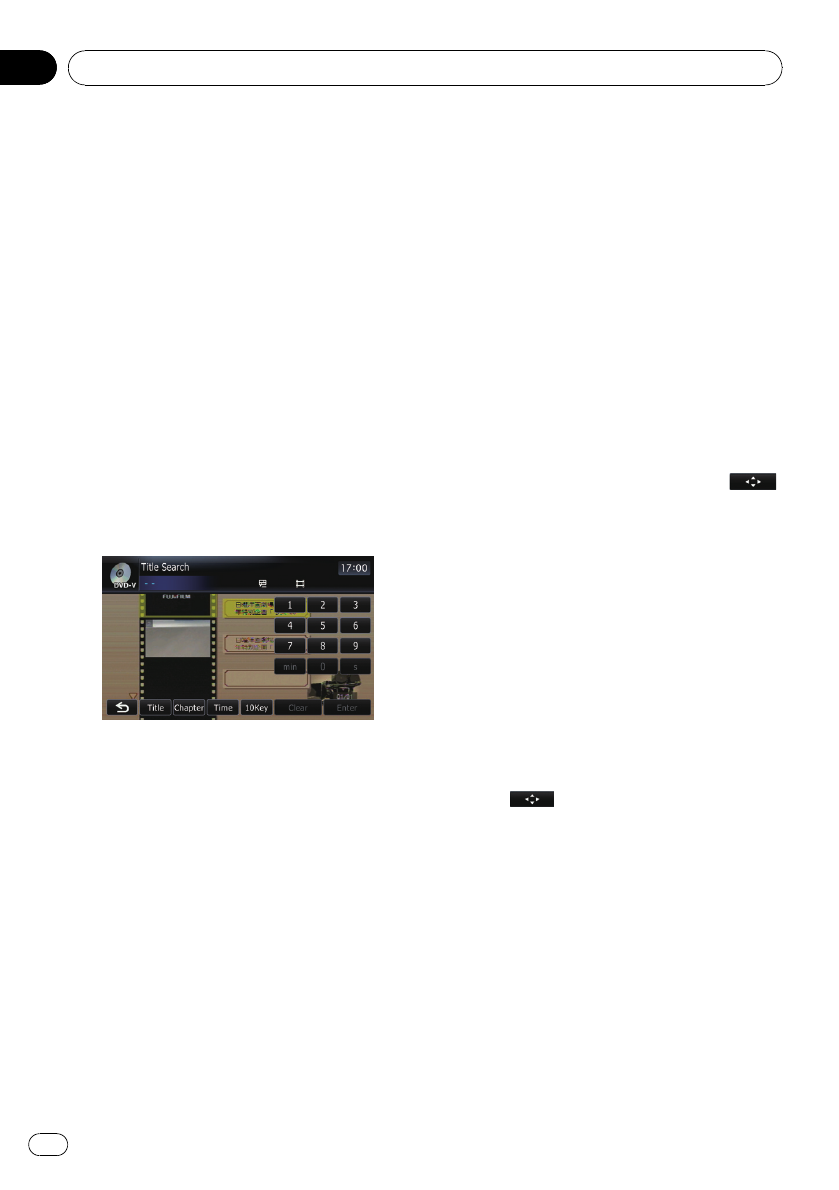
%Touching [BookM.]:
You can bookmark one point for each of up to
five discs. If you try to memorize another point
for the same disc, the oldest bookmark will be
overwritten by the newest one.
pTo clear the bookmark on a disc, touch and
hold [BookM.].
Searching for a specific scene
and starting playback from a
specified time
You can search for the scene you want by spe-
cifying a title or a chapter, and the time.
pChapter search and time search are not
possible when disc playback has been
stopped.
1 Touch [Search] and then touch [Title]
(title), [Chapter] (chapter), [Time] (time).
2 Touch the keys to input the target num-
ber or time and then touch [Enter].
For titles, chapters
!To select 3, touch [3] and [Enter] in order.
!To select 10, touch [1] and [0] and [Enter]in
order.
For time (time search)
!To select 5 minutes 03 seconds, touch [5],
[min], [0], [3] and [Enter] in order.
!To select 71 minutes 00 seconds, touch [7],
[1], [min], [0], [0] and [Enter] in order.
!To select 100 minutes 05 seconds, touch
[1], [0], [0], [5], [s] and [Enter] in order.
pTo cancel an input number, touch [Clear].
To cancel the input numbers, touch and
hold [Clear].
Direct number search
You can use this function when you need to
enter a numerical command during DVD play-
back.
1 Touch [10Key].
2 Touch [0] to [9] to input the desired
number.
3 While the input number is displayed,
touch [Enter].
Operating the DVD menu
You can operate the DVD menu by touching
the menu item on the screen directly.
pThis function can be used when the
key is displayed on the lower right corner of
the LCD screen.
pThis function may not work properly with
some DVD disc content. In that case, use
touch panel keys to operate the DVD menu.
pNew translation required.
1 Touch the screen to display the touch
panel keys.
2 Touch [Top Menu] or [Menu] to display
touch panel keys to operate the DVD
menu.
3 Touch the desired menu item.
#Touch .
New translation required.
Using DVD menu by touch
panel keys
If items on the DVD menu appear, the touch
panel keys may overlay them. If so, select an
item using those touch panel keys.
Playing a DVD-Video
En
116
Chapter
19
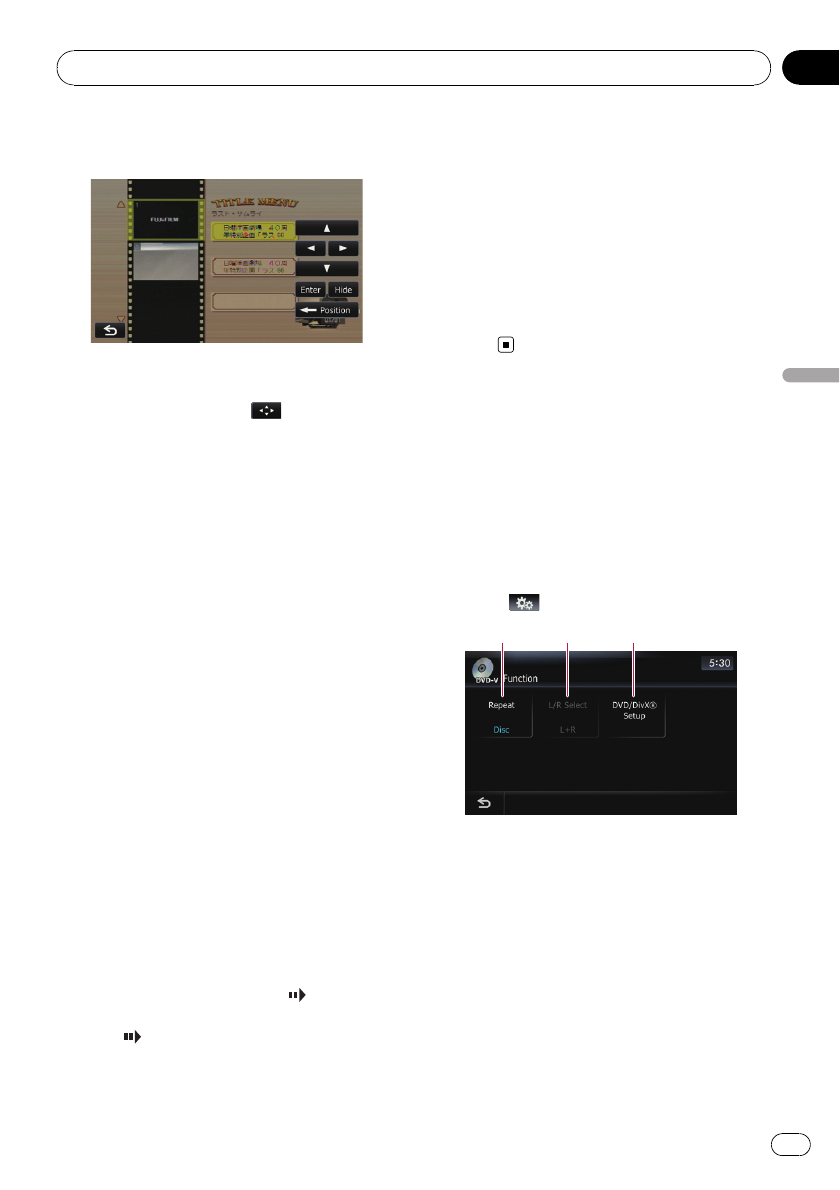
1 Touch [a], [b], [c]or[d] to select the
desired menu item.
pIf the touch panel keys for DVD menu selec-
tion disappear, touching anywhere on the
screen, then touching displays them
again.
2 Touch [Enter].
Playback starts from the selected menu item.
The way to display the menu differs depending
on the disc.
#Touch [Position].
Each touch of [Position] changes the display po-
sition of touch panel keys.
#Touch [Hide].
New translation required.
Frame-by-frame playback
This lets you move ahead one frame at a time
during playback.
%Touch [r] during playback.
Each time you touch [r], you move ahead
one frame.
To return to normal playback, touch [f].
pWith some discs, images may be unclear
during frame-by-frame playback.
Slow motion playback
This lets you slow down playback speed.
1 Touch and hold [r] until is dis-
played during playback.
The icon is displayed, and forward slow
motion playback begins.
pTo return to normal playback, touch [f].
2 Touch [q]or[r] to adjust playback
speed during slow motion playback.
Each time you touch [q]or[r] it changes
the speed in four steps in the following order:
1/16 f1/8 f1/4 f1/2
pThere is no sound during slow motion play-
back.
pWith some discs, images may be unclear
during slow motion playback.
pReversed slow motion playback is not possi-
ble.
Using the “Function”menu
1 Touch [DISC] on the “AV Source”menu
to display the “DVD-V”screen.
=For details concerning operations, refer to
Screen switching overview on page 34.
2 Touch the screen to display the touch
panel keys.
3 Touch .
1 2 3
1Repeating play
Each touch of [Repeat] changes the setting
as follows:
!Disc —Plays throughout the current
disc
!Title —Repeats just the current title
!Chapter —Repeats just the current
chapter
pIf you perform chapter (title) search, fast
forward/rewind or slow motion playback,
the repeat play range changes to [Disc].
pThis function is not available when disc
playback has been stopped.
Playing a DVD-Video
En 117
Chapter
19
Playing a DVD-Video

2Selecting audio output
When playing DVDs recorded with LPCM
audio, you can switch the audio output.
Touch [L/R Select] repeatedly until the de-
sired audio output appears in the display.
Each touch of [L/R Select] changes the set-
tings as follows:
!L+R —Left and right
!L—Left
!R—Right
!Mix —Mixing left and right
pThis function is not available when disc
playback has been stopped.
3DVD setup adjustments
=For details, refer to Displaying DVD/
DivX® Setup menu on page 126.
Playing a DVD-Video
En
118
Chapter
19
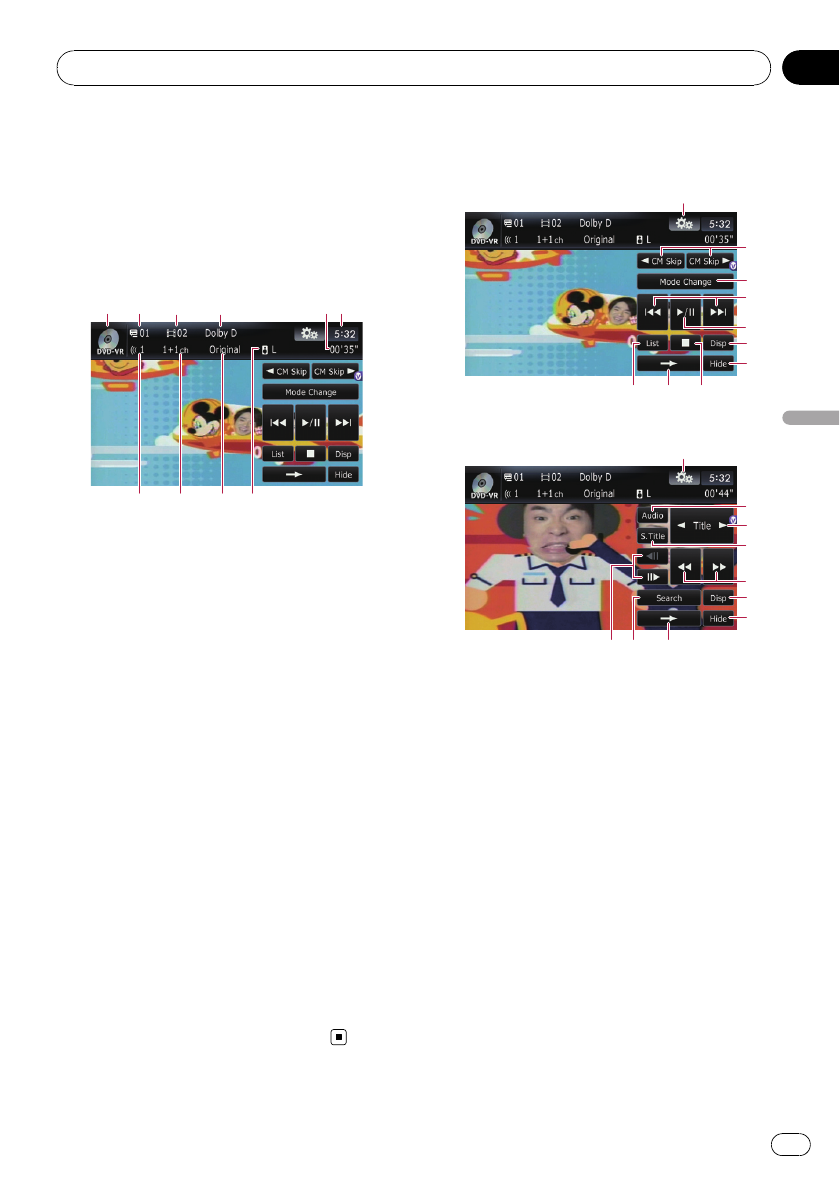
You can play a DVD-VR (DVD Video Recording
Format) disc using the built-in drive of the na-
vigation system. This section describes opera-
tions for DVD-VR discs.
Reading the screen
1 2 43 65
879a
1Source icon
Shows which source has been selected.
2Title number indicator
Shows the title number currently playing.
3Chapter number indicator
Shows the chapter currently playing.
4Digital sound format indicator
Shows which digital sound format (surround
sound format) has been selected.
5Play time indicator
Shows the elapsed playing time within the
current title.
6Current time
7Audio track indicator
Shows the audio track number currently se-
lected.
8Audio channel indicator
Shows the current audio channel type, such
as “Mch”(Multi-channel).
9Play mode indicator
Shows the current play mode.
=For details, refer to Switch the play-
back mode on page 121.
aMixing condition indicator
Shows the current mixing condition.
Using the touch panel keys
Playback screen (page1)
3
6
7
89
4
1
a
5
2
Playback screen (page2)
c
6
7
g9
d
1
f
e
b
pWith some discs, the icon 9may be dis-
played, meaning that the operation is not
valid.
1Display the “Function”menu
=For details, refer to Using the
“Function”menu on page 122.
2cCM Back/CM Skip d
=For details, refer to Using the short-
time skip function on page 121.
3Switch the playback mode
=For details, refer to Switch the play-
back mode on page 121.
4Skip forward or backward
Touching [p] skips to the start of the next
chapter. Touching [o] once skips to the
start of the current chapter. Touching it again
will skip to the previous chapter.
pYou can also perform these operations
by using the TRK (c/d) button.
5Playback and Pause
Playing a DVD-VR disc
En 119
Chapter
20
Playing a DVD-VR disc
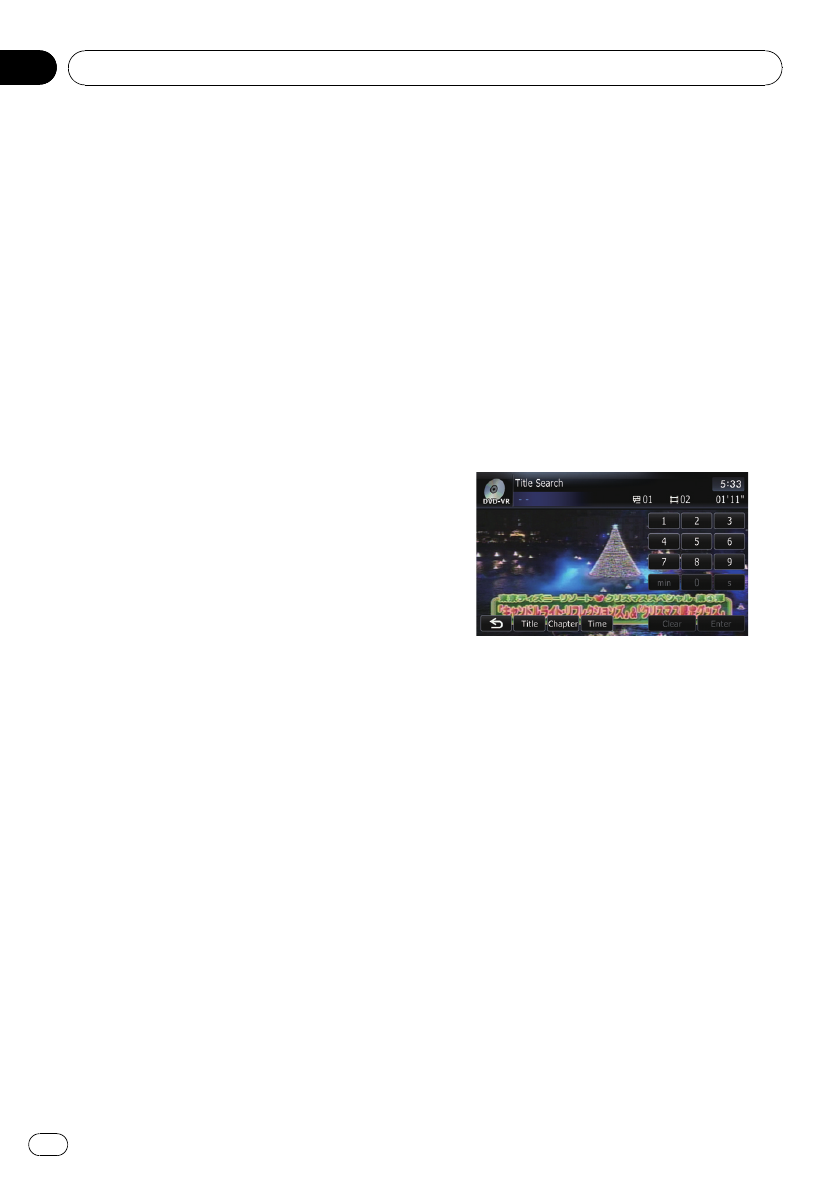
Touching [f] switches between “playback”
and “pause”.
6Switch the display
Touching [Disp] changes the information as
follows:
Disc information display —Repeat range dis-
play
7Hide the touch panel keys
Touching [Hide] hides the touch panel keys.
Touch anywhere on the LCD screen to display
the touch panel keys again.
8Display the title list
Displays the title list recorded on the disc.
9Switch next page of touch panel keys
aStop playback
bChange audio tracks (Multi-audio)
Each touch of [Audio] switches between
audio tracks.
pDisplay indications such as MPEG-A
and Mch indicate the audio system re-
corded on the DVD. Depending on the
setting, playback may not use the same
audio system as that indicated.
cSkip the title forward or backward
Touching [d] skips to the start of the next title.
Touching [c] skips to the start of the previous
title.
dChange the subtitle (Multi-subtitle)
Each touch of [S.Title] switches between the
subtitle languages.
eFast reverse or forward
Touch [m]or[n] to perform fast reverse or
forward.
If you touch and hold [m]or[n] for five
seconds, fast reverse/fast forward continues
even if you release either of these keys. To re-
sume playback at a desired point, touch
[f], [m]or[n] opposite to key pushed
for five seconds.
fFrame-by-frame playback (or slow-motion
playback)
=For details, refer to Frame-by-frame play-
back on the next page.
=For details, refer to Slow motion playback
on the next page.
gSearching for a desired scene and starting
playback from a specified time
=For details, refer to Searching for a speci-
fic scene and starting playback from a
specified time on this page.
Searching for a specific scene
and starting playback from a
specified time
You can search for the scene you want by spe-
cifying a title or a chapter, and the time.
pChapter search and time search are not
possible when disc playback has been
stopped.
1 Touch [Search] and then touch [Title]
(title), [Chapter] (chapter), [Time] (time).
2 Touch the keys to input the target num-
ber or time and then touch [Enter].
For titles, chapters
!To select 3, touch [3] and [Enter] in order.
!To select 10, touch [1] and [0] and [Enter]in
order.
For time (time search)
!To select 5 minutes 03 seconds, touch [5],
[min], [0], [3] and [Enter] in order.
!To select 71 minutes 00 seconds, touch [7],
[1], [min], [0], [0] and [Enter] in order.
!To select 100 minutes 05 seconds, touch
[1], [0], [0], [5], [s] and [Enter] in order.
pTo cancel an input number, touch [Clear].
To cancel the input numbers, touch and
hold [Clear].
Playing a DVD-VR disc
En
120
Chapter
20